Thailand Trip Report 2024
Our 2024 birdwatching tour through central and northern Thailand was a feast for the senses—shimmering rice paddies brimming with waterbirds, salt pans with swirling clouds of shorebirds, and misty mountain valleys echoing with the calls of barbets and hornbills. Over the course of the trip, we recorded 403 species of birds and compiled an impressive list of mammals—with a few exciting firsts for this itinerary. Between birding adventures, we savored fragrant Thai curries, fresh tropical fruits, and delicious street food, making the journey as much a culinary delight as a birding paradise.
Day 1
Before the official start to the tour at dinner, many of us birded the grounds of Park Nine Hotel and the nearby klong (canal), and had a nice introduction to the more common birds of Thailand. Highlights included Pink-necked Green-Pigeon, Asian Koel, Plaintive Cuckoo, House Swift, Asian Palm Swift, White-throated Kingfisher, Blue-tailed Bee-eater, Coppersmith Barbet, Oriental Magpie-Robin and several sunbirds.
Day 2
We barely leave the parking lot, when we notice several fruiting trees near the edge of the hotel. We make a quick stop to check out the feeding frenzy of pigeons, barbets, bulbuls, and orioles at close range.
Next stop is Lad Krabang Agriculture Lands–a patchwork of rice paddies, aquaculture ponds and fallow fields on the fringes of Bangkok. We spent much of our first morning exploring this mosaic looking for a wide diversity of wetland and open field birds. Birds are numerous in these transitional habitats, and we got a crash course in many of the common Southeast Asian birds we’ll see much of the tour. We did manage to find a few that won’t find their way on our lists again such as Watercock, Eurasian Kestrel, Bluethroat, Red Avadavat. Other highlights were Little Grebe, White-breasted Waterhen, Bronze-winged Jacana, side-by-side comparisons of White-winged and Whiskered Terns, a perfect line-up of all the Egrets, Asian Openbill, Painted Stork, Spot-billed Pelican, Yellow Bittern, White-throated Kingfisher, Blue-tailed Bee-eater, Indochinese Roller, and all 3 species of Weaver.
As we departed Bangkok, we stopped at two different temple complexes (Wat Chalerm Phrakiet and Wat Saun Yai Temples) to see Alexandrine Parakeet and Spotted Owlet. In addition to these targets, we find a very out-of-range male Van Hasselt’s Sunbird.
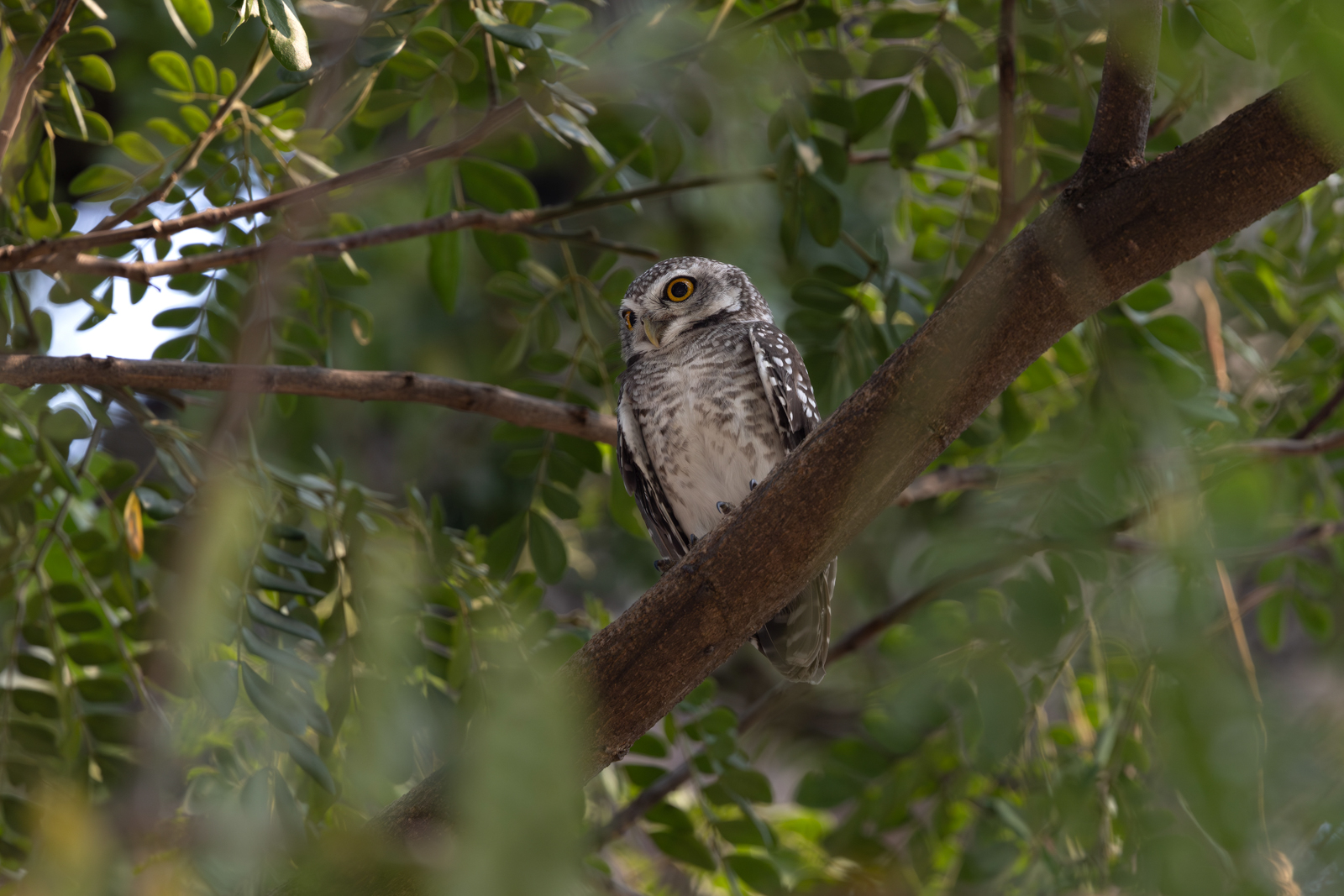
Spotted Owlet © Chris Burney
In the afternoon, we made one last stop for various mangrove specialists at the Mahachai Mangrove Forest Learning & Development Center. Highlights included Green-billed Malkoha, Oriental Darter, Brahimny Kite, Collared Kingfisher, Golden-bellied Gerygone, Racket-tailed Treepie. Mudskippers are new for most of the group, a we see several Giant Mudskippers hopping through the shallows.
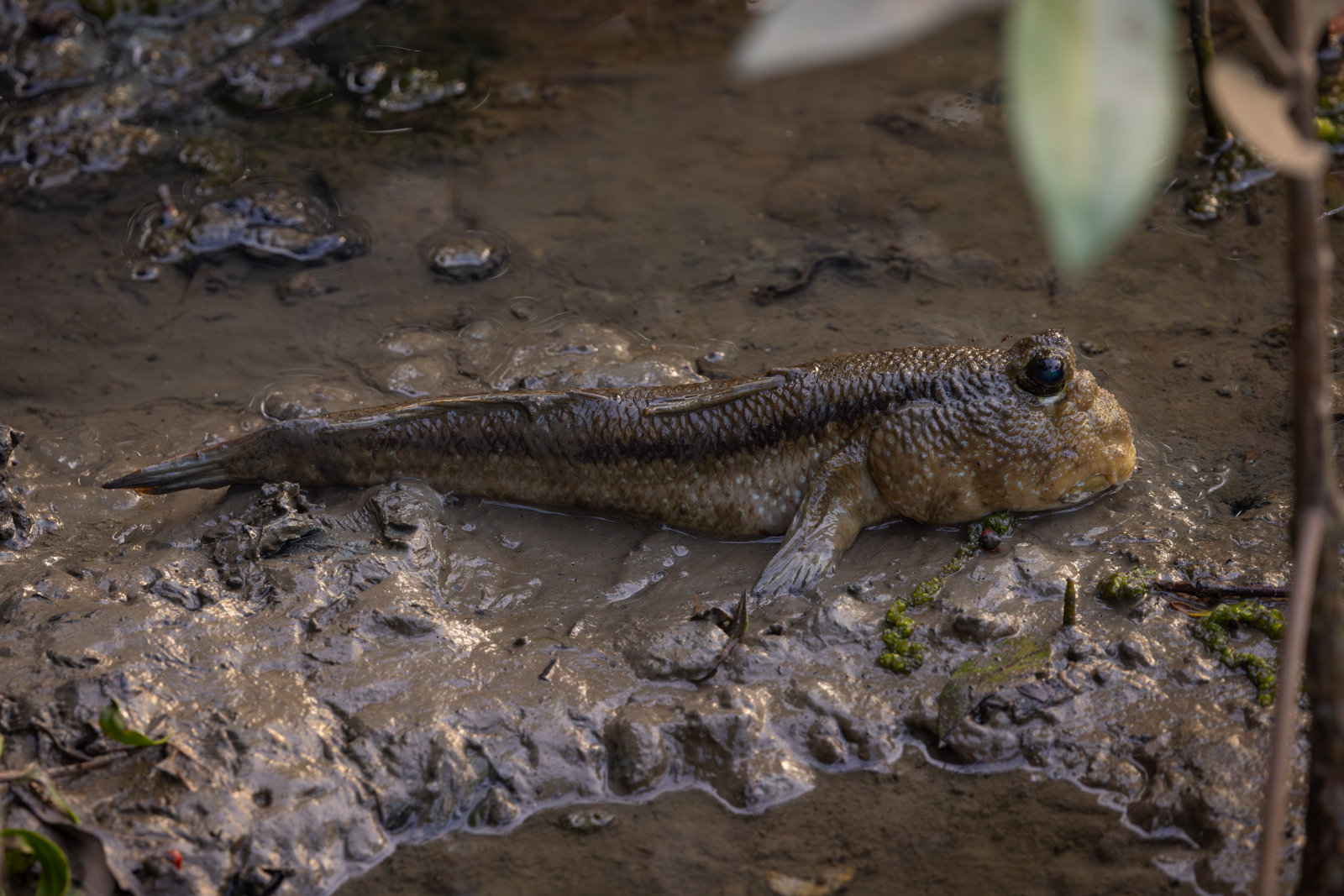
Giant Mudskipper © Chris Burney
Day 3
We started early looking for our day’s main target, the Spoon-billed Sandpiper at Khok Kham Bird Center. These protected salt pans are covered with thousands of shorebirds so it felt like we were looking for a needle in a haystack. Thankfully, our local guide spotted one fairly quickly. Spoon-billed are paler in comparison to most wintering stints, and this difference can be noticeable from a distance. As we crept closer, the bird flew in closer and was joined by a second individual! While the light is nice and the heat shimmer is minimal, we quickly scanned through the dense flocks and studied the differences between various closely related species. Highlights were Pacific Golden-Plover, Tibetan Sand-Plover, Greater Sand-Plover, Black-tailed Godwit, Great Knot, Red Knot, Broad-billed Sandpiper, Curlew Sandpiper, Spoon-billed Sandpiper, and Little Tern.
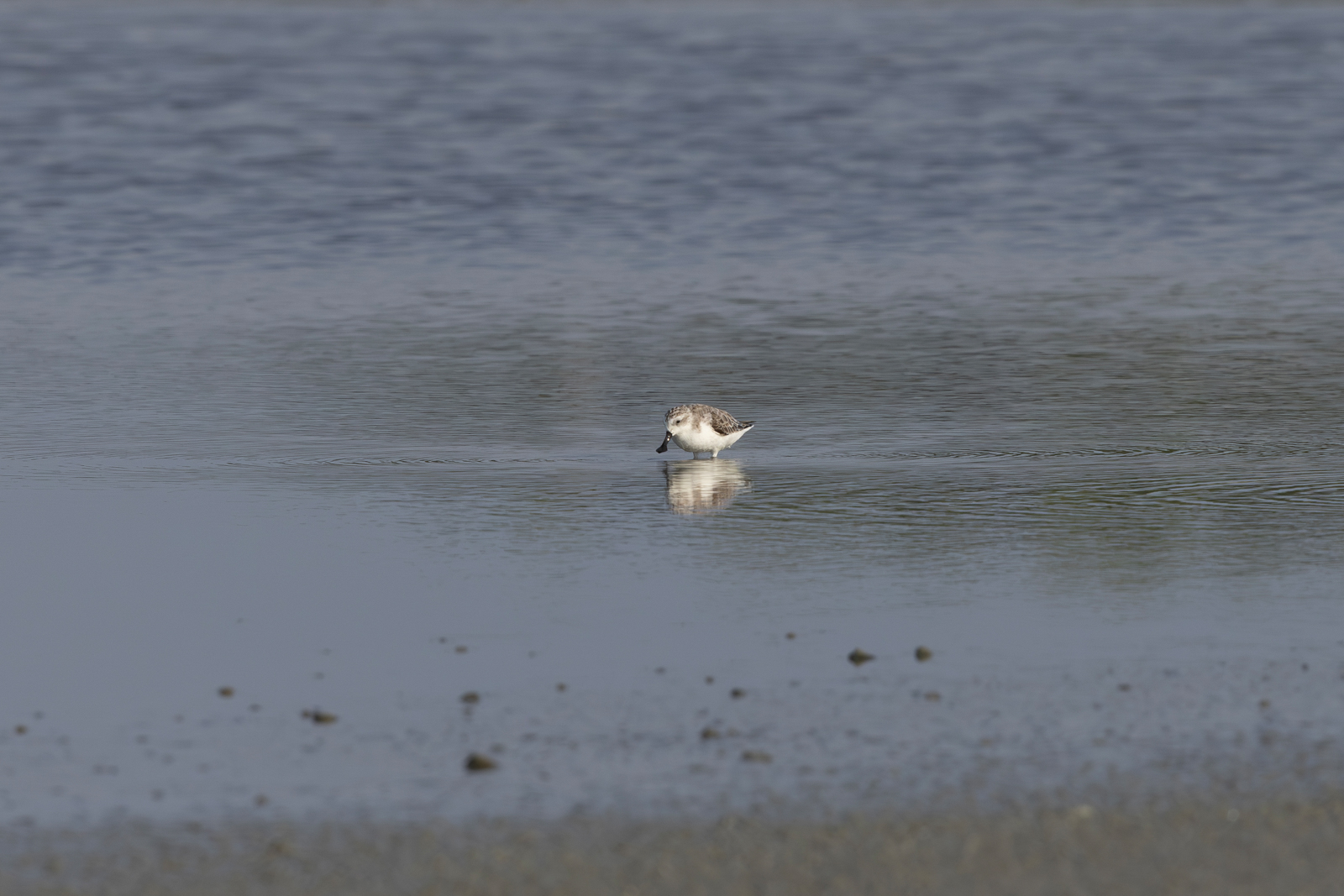
Spoon-billed Sandpiper © Chris Burney
We continued southward towards the shorebird Mecca of Pak Thale, making several stops along the way at more freshwater ponds and rice paddies looking for a few species we missed the previous day. Highlights included Oriental Reed Warbler, Black-browed Reed Warbler, Lesser Whistling-Duck, Cotton Pygmy-Goose, Garganey, Greater Coucal, Gray-headed Swamphen, Pheasant-tailed Jacana, and Bronze-winged Jacana.
Lunch was near Pak Thale, and while the food was getting prepared, we checked out some of the coast nearby. We had great views of a very obliging Black-capped Kingfisher, and our first Collared Kingfisher and Eurasian Curlews of the trip.
We spent the rest of the day exploring the famous Laem Phak Bia and Pak Thale. Thousands of shorebirds winter on the salt pans and beaches of this part of Thailand. Since we had amazing looks at Spoon-billed Sandpipers earlier, we had more opportunity for the other shorebird targets, namely Asian Dowitcher and Nordmann’s Greenshank which we found in quick time! We then took the boat trip out to the sandspit to look for Chinese Egret, Malaysian Plover and White-faced Plover – we dipped on the egret, but got excellent views of the plovers. Other highlights included Whimbrel, Bar-tailed and Black-tailed Godwits, Terek Sandpiper, Common and Spotted Redshanks, Red-necked Phalarope, Great and Red Knots, Ruddy Turnstone, Ruff, Gull-billed Tern, Caspian Tern, and various Kingfishers.
Day 4
We spent the entire day in Kaeng Krachan National Park which is Thailand’s largest national park, occupying 2915 square kilometres (1125 sq. miles). This park is also part of a larger complex of protected areas that encompass 4822 square kilometres (1862 sq. miles) in the Tenasserim Range on the boundary between Thailand and Myanmar. We explored both the lower and upper sections of the main road through the park – starting in a mix of dry deciduous forest and transitioning to evergreen as we climb higher in elevation. So many things are possible in a day at Kaeng Krachan NP–not just birds, but mammals as well.
We started the day with 3 owl species: Asian Barred Owlet, Collared Scops-Owl, and one of the biggest highlights of the trip, a roosting White-fronted Scops-Owl–a very rare and difficult bird to see much of the time. We also saw several primates: Robinson’s Banded Langur, Dusky Leaf Monkey and Lar Gibbon. Other Highlights included Crested Goshawk, Oriental Pied-Hornbill, Greater Yellownape, Vernal Hanging-Parrot, Golden-crested Myna, Yellow-vented Green-Pigeon, Great Hornbill, Wreathed Hornbill, Red-bearded Bee-eater, Golden Babbler, Collared Babbler, Pin-tailed Parrotfinch, Chestnut-headed Bee-eater, Banded Kingfisher, Large Woodshrike, Thick-billed Flowerpecker, Gray-rumped Treeswift, White-browed Scimitar-Babbler, various Barbets, Silver-breasted Broadbill, Common Green-Magpie, Sultan Tit, Greater Flameback, Great Slaty Woodpecker, and Banded Broadbill. We also found a few reptiles today: Oriental Whipsnake, Clouded Monitor and Asian Painted Frog. Kaeng Krachen National Park also has an impressive butterfly list, and we saw thousands throughout the day, especially around the elephant dung piles.
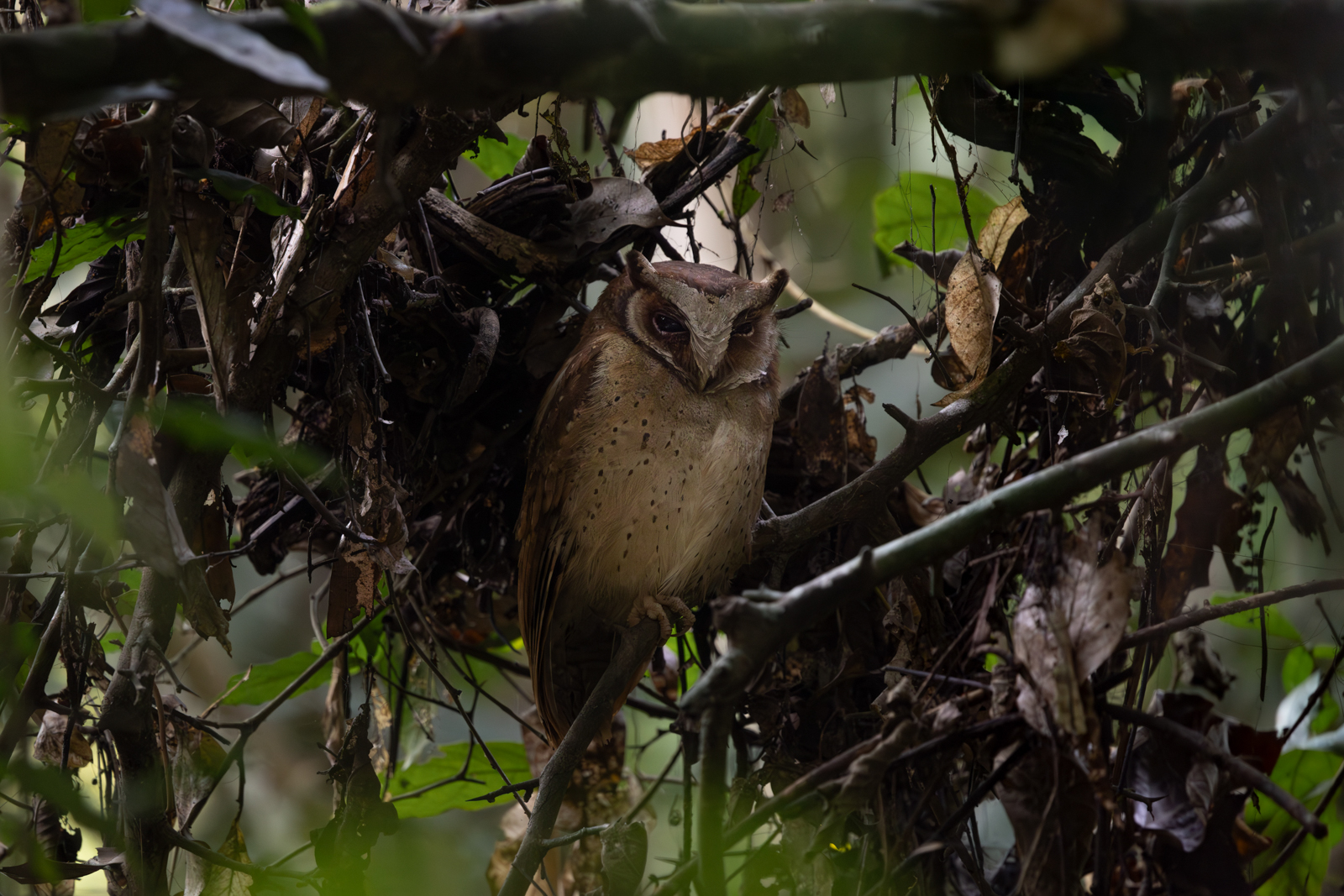
White-fronted Scops-Owl © Chris Burney
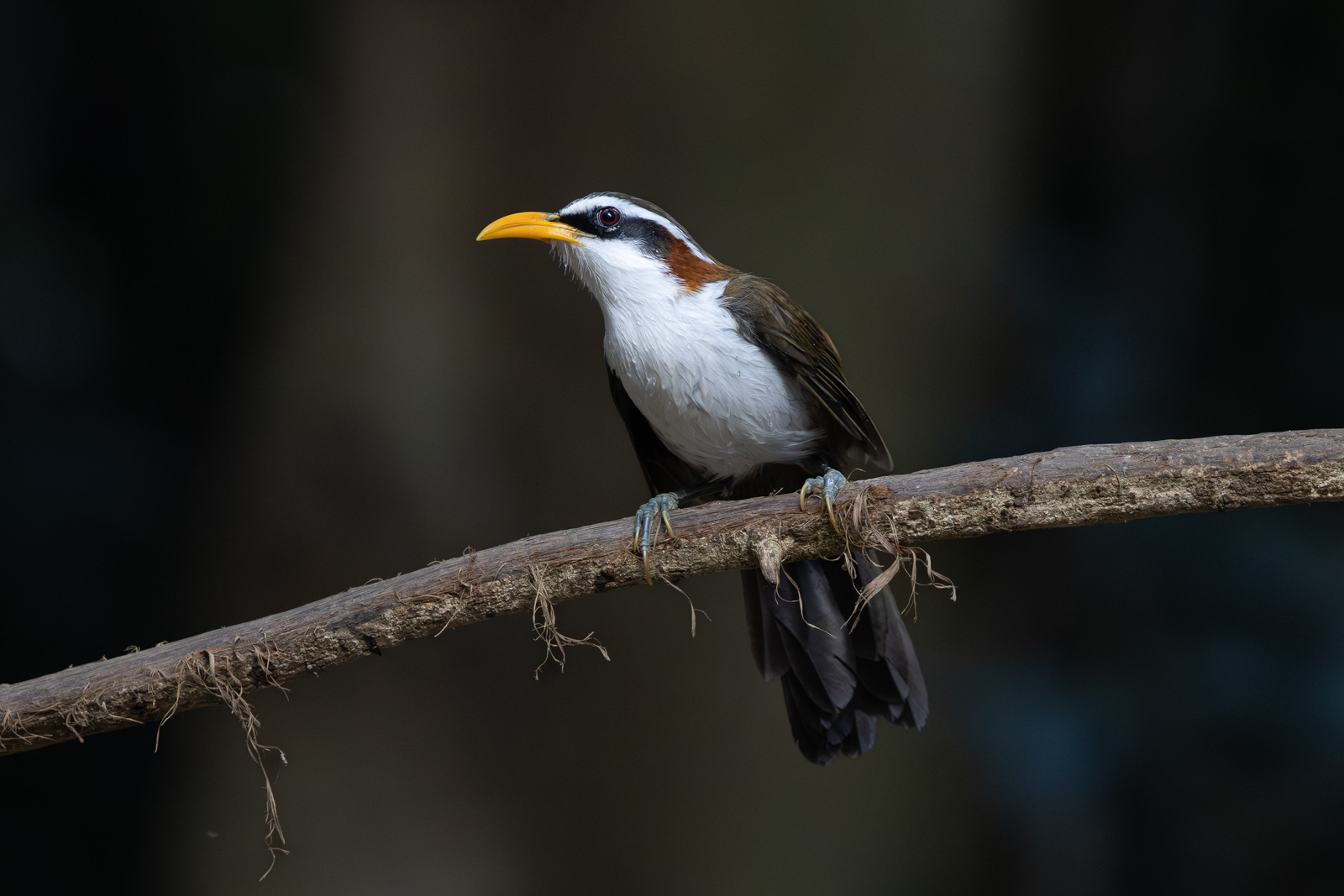
White-browed Scimitar-Babbler © Chris Burney
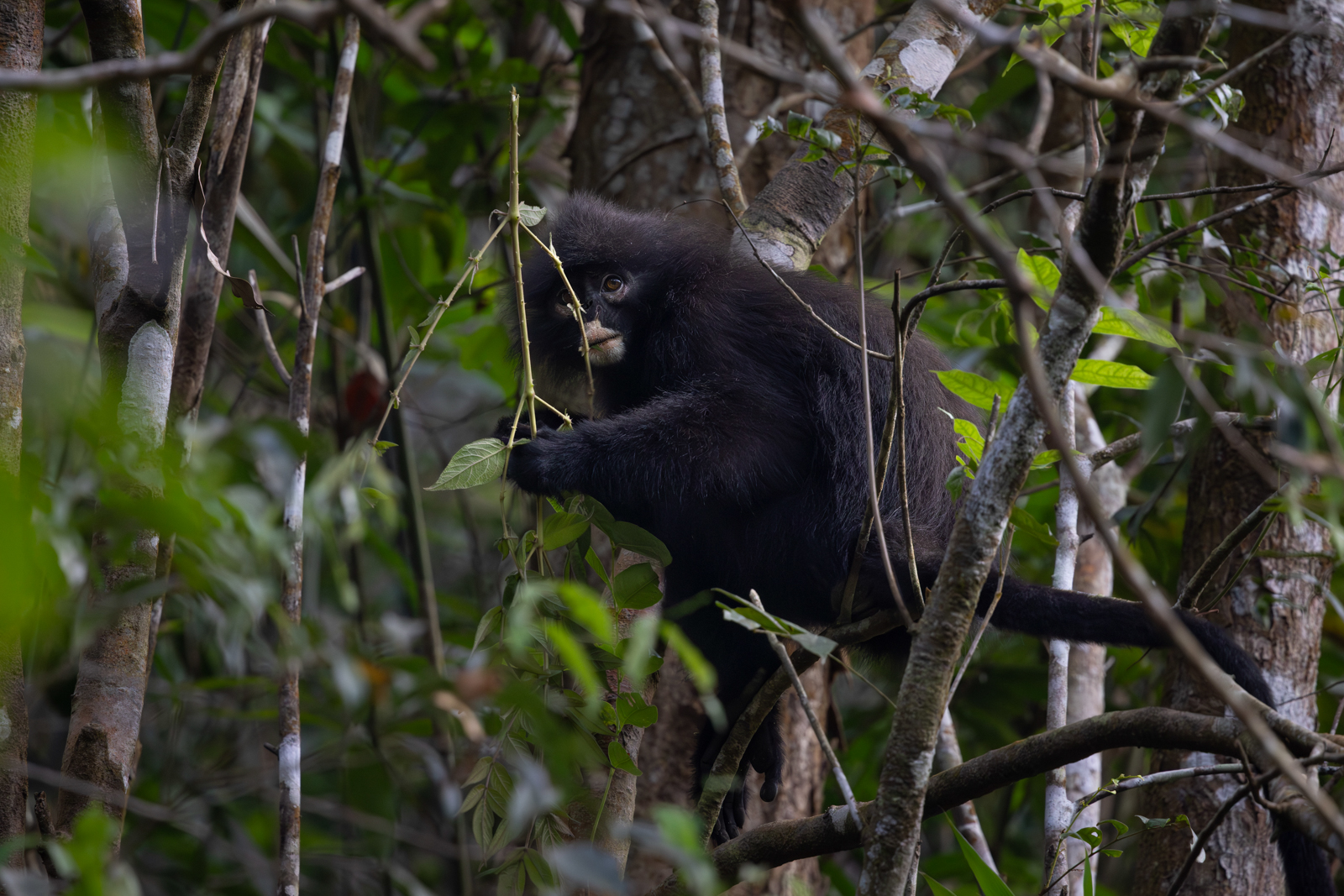
Robinson’s Banded Langur © Chris Burney
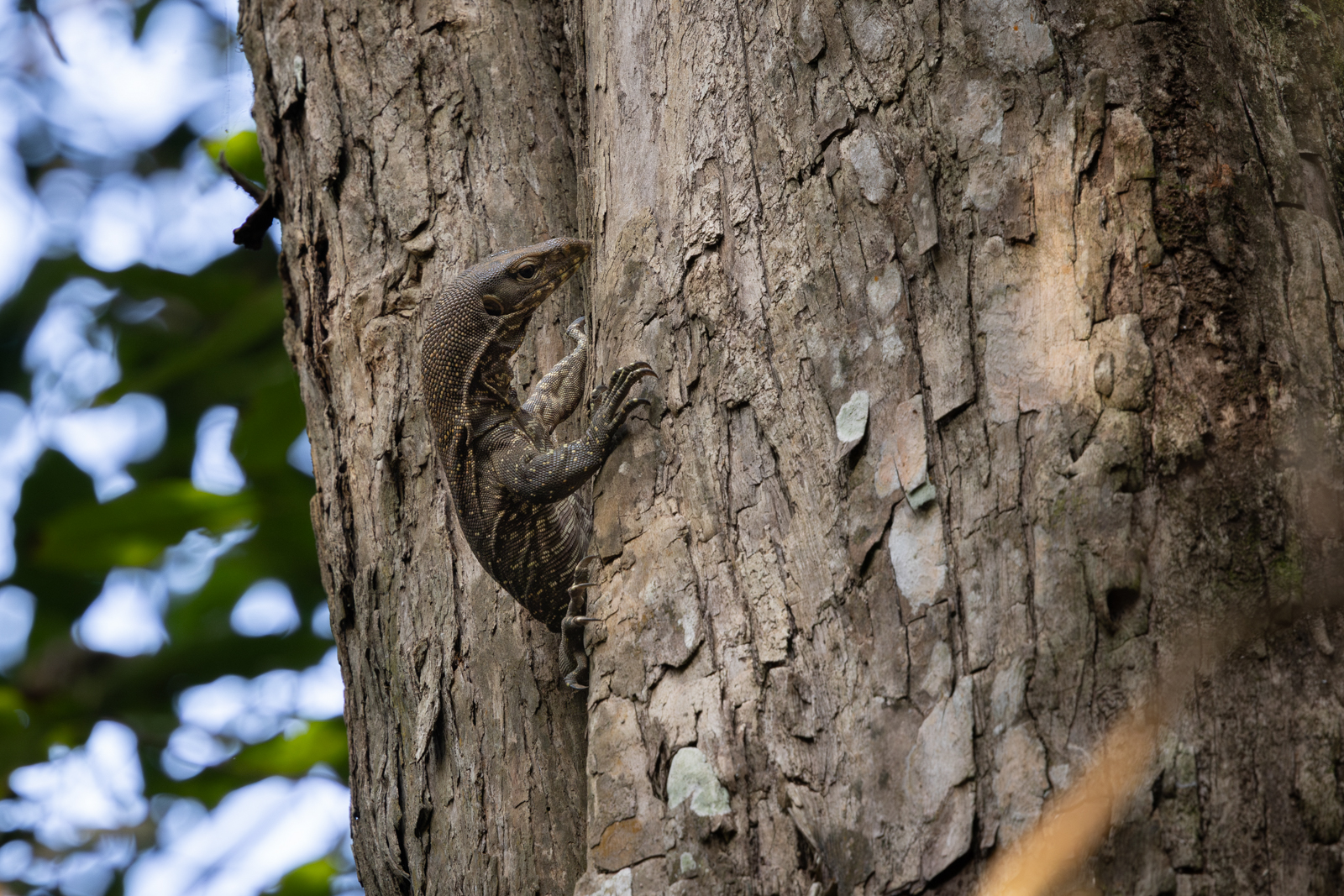
Clouded Monitor © Chris Burney
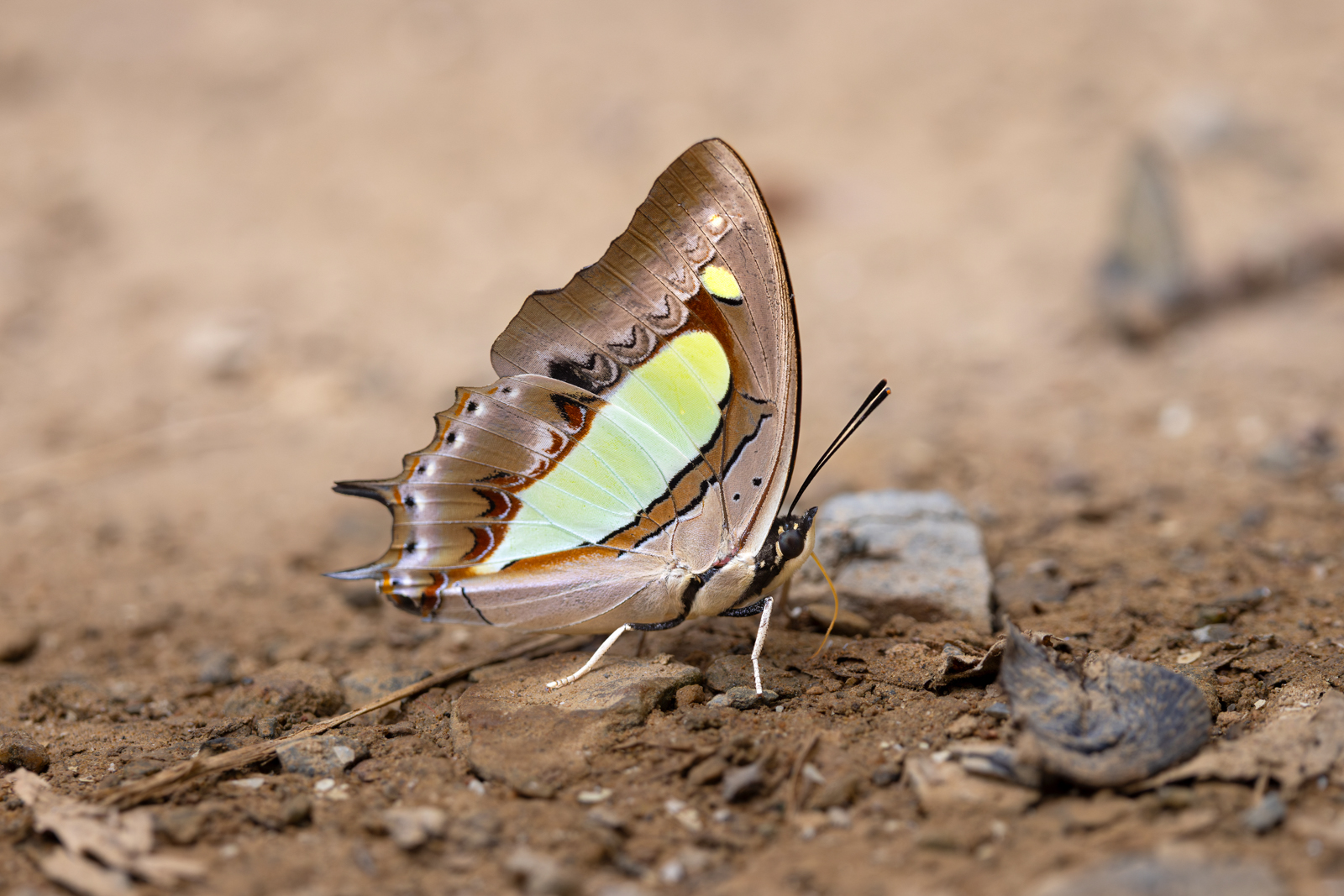
Common Nawab © Chris Burney
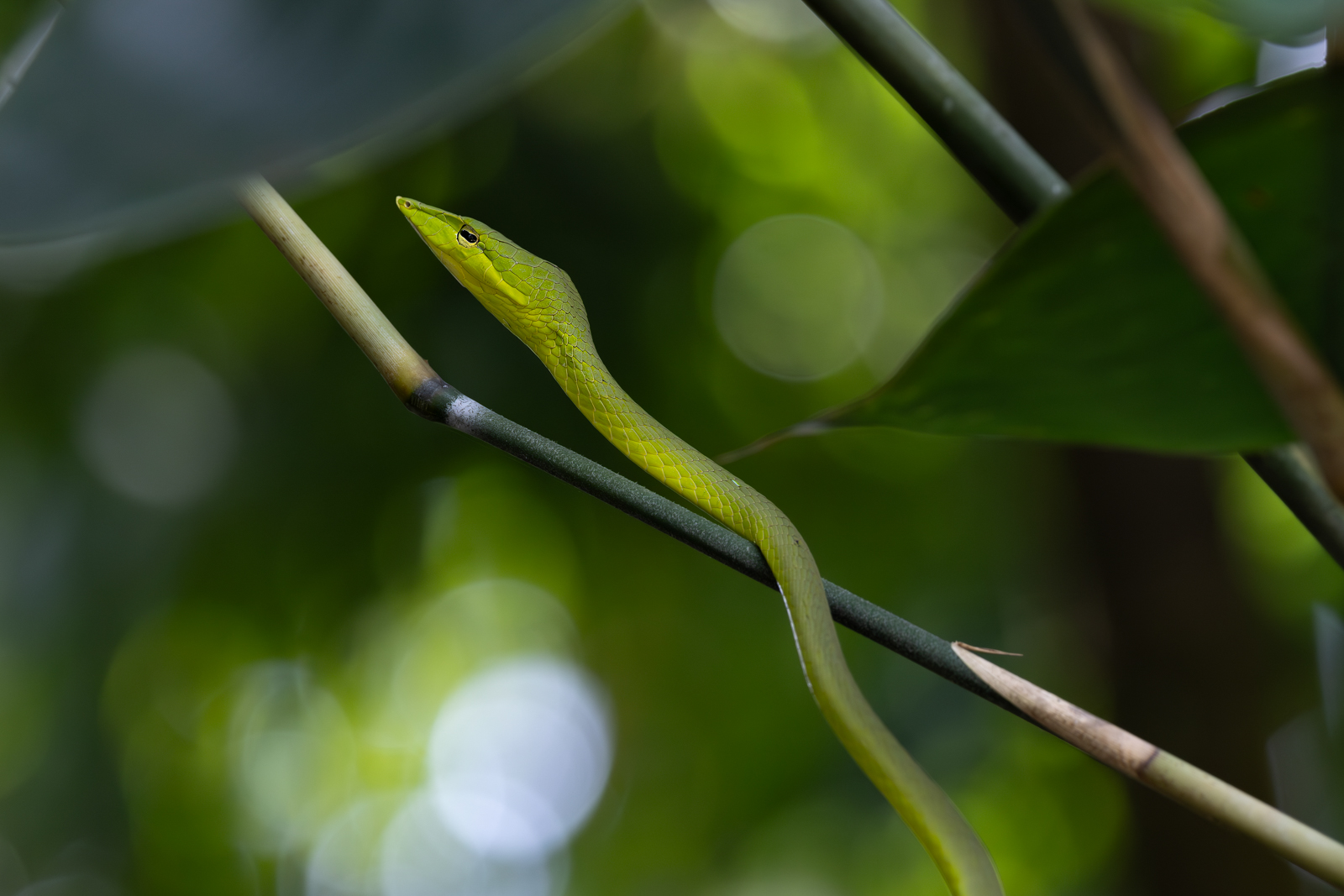
Oriental Whipsnake © Chris Burney
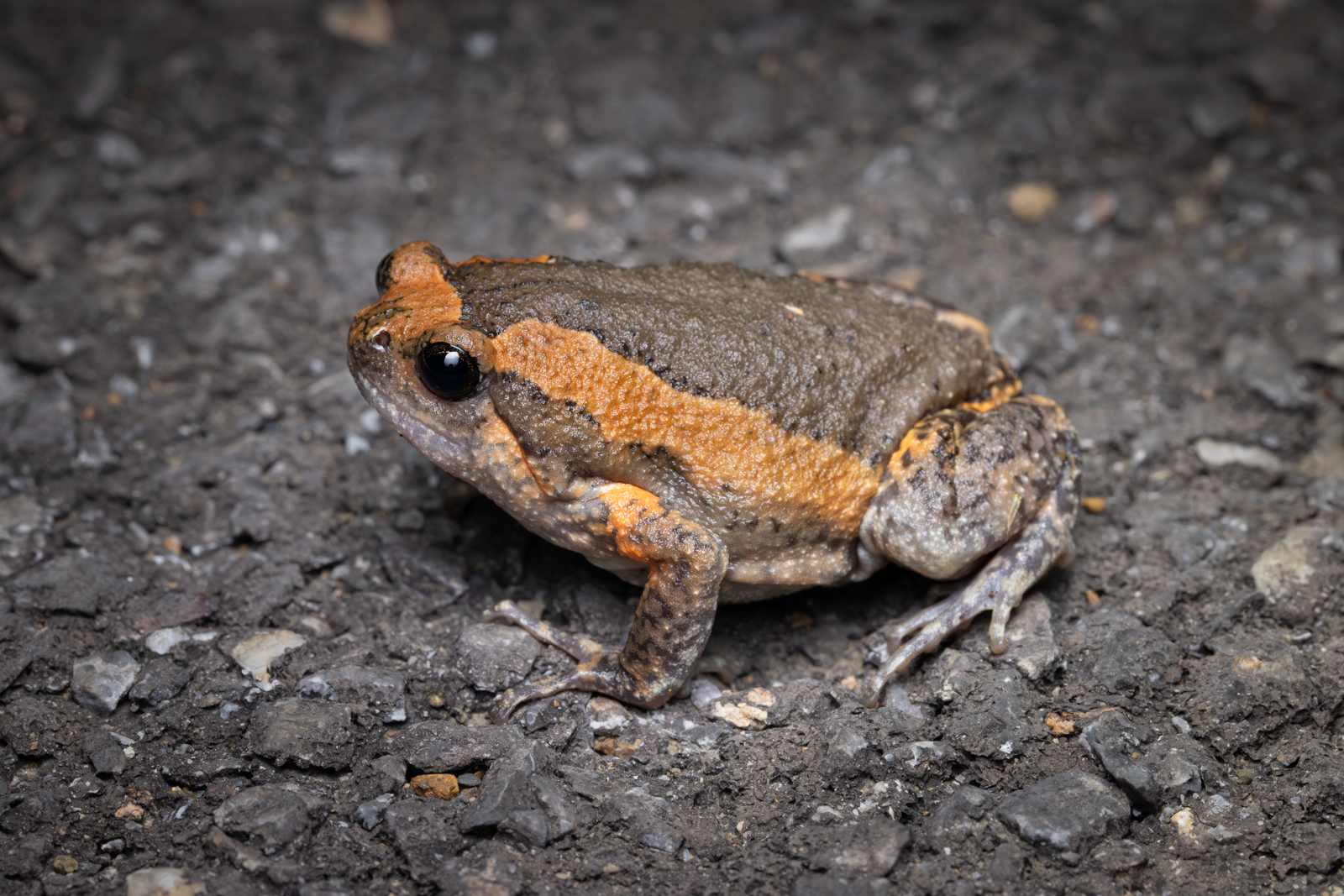
Asian Painted Frog © Chris Burney
Day 5
We started the morning on the grounds of Baan Maka Nature Lodge where we found a nice flock feeding on flowers and fruit near the lodge pond – Greater Green Leafbird being the best of the bunch.
We then spent the rest of the day at the bird blinds near Kaeng Krachan National Park. Historically, these blinds were used by poachers for subsistence hunting and sale in local markets. Species particularly hard hit were gamebirds and deer. In addition, various passerines such as White-rumped Shama were captured for the cage-bird trade. Beginning in 2008, nearby lodges convinced the poachers to use the blinds strictly for ecotourism – birdwatchers would pay an entry fee that would go directly to the local community. The blinds offered amazing views of many rare and hard-to-see species. Mammal highlights included Lesser Oriental Chevrotain, Northern Treeshrew, and Gray-bellied Squirrel. Bird highlights included Ferruginous Partridge, Bar-backed Partridge, Kalij Pheasant, Scaly-breasted Partridge, Gray Peacock-Pheasant, Red Junglefowl, Common Flameback, Large Scimitar-Babbler, Puff-throated Babbler, Abbot’s Babbler, Brown-cheeked Fulvetta, Greater and Lesser Necklaced Laughingthrush, White-crested Laughingthrush, Chinese and Indochinese Blue Flycatchers, and Siberian Blue Robin.
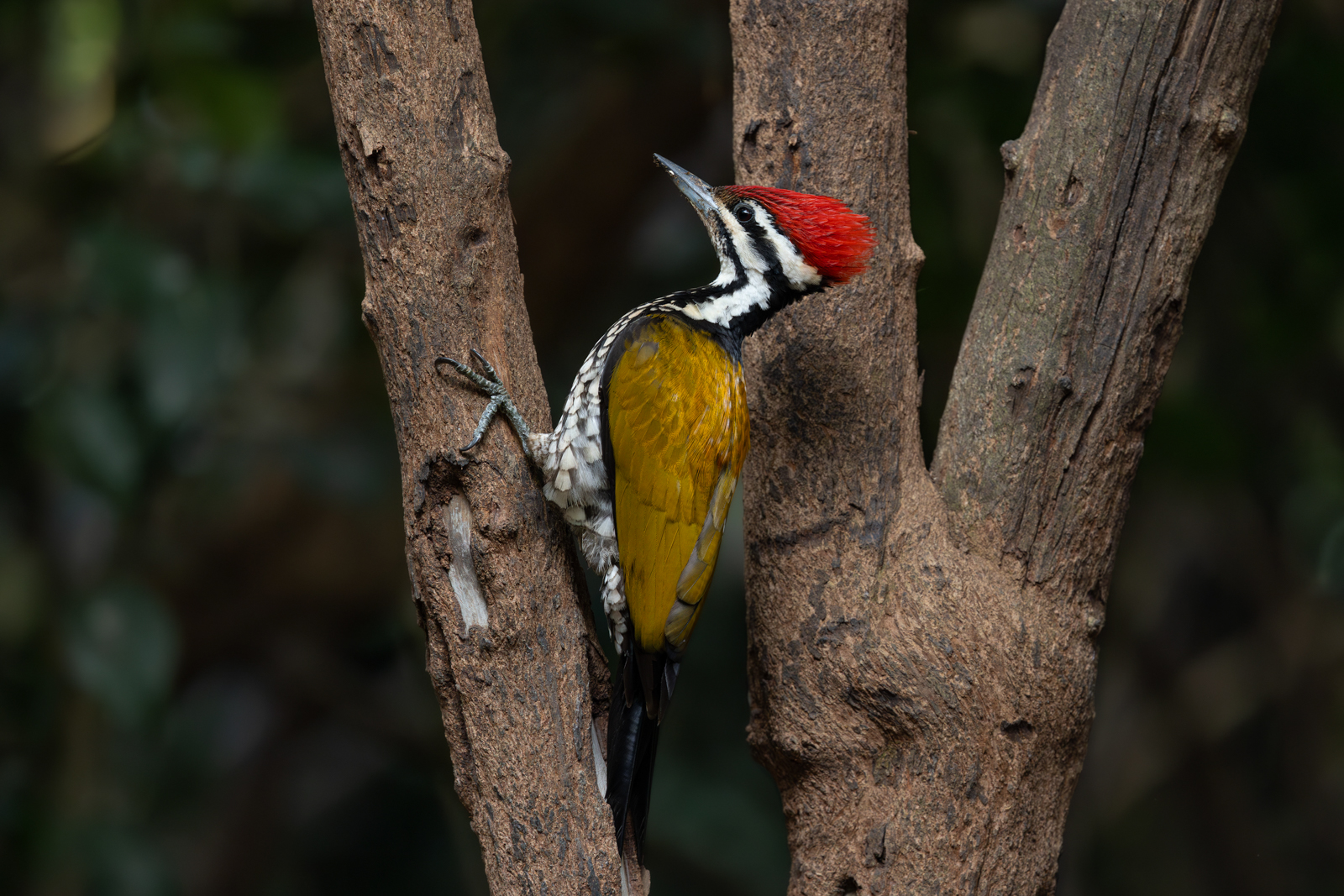
Common Flameback © Chris Burney
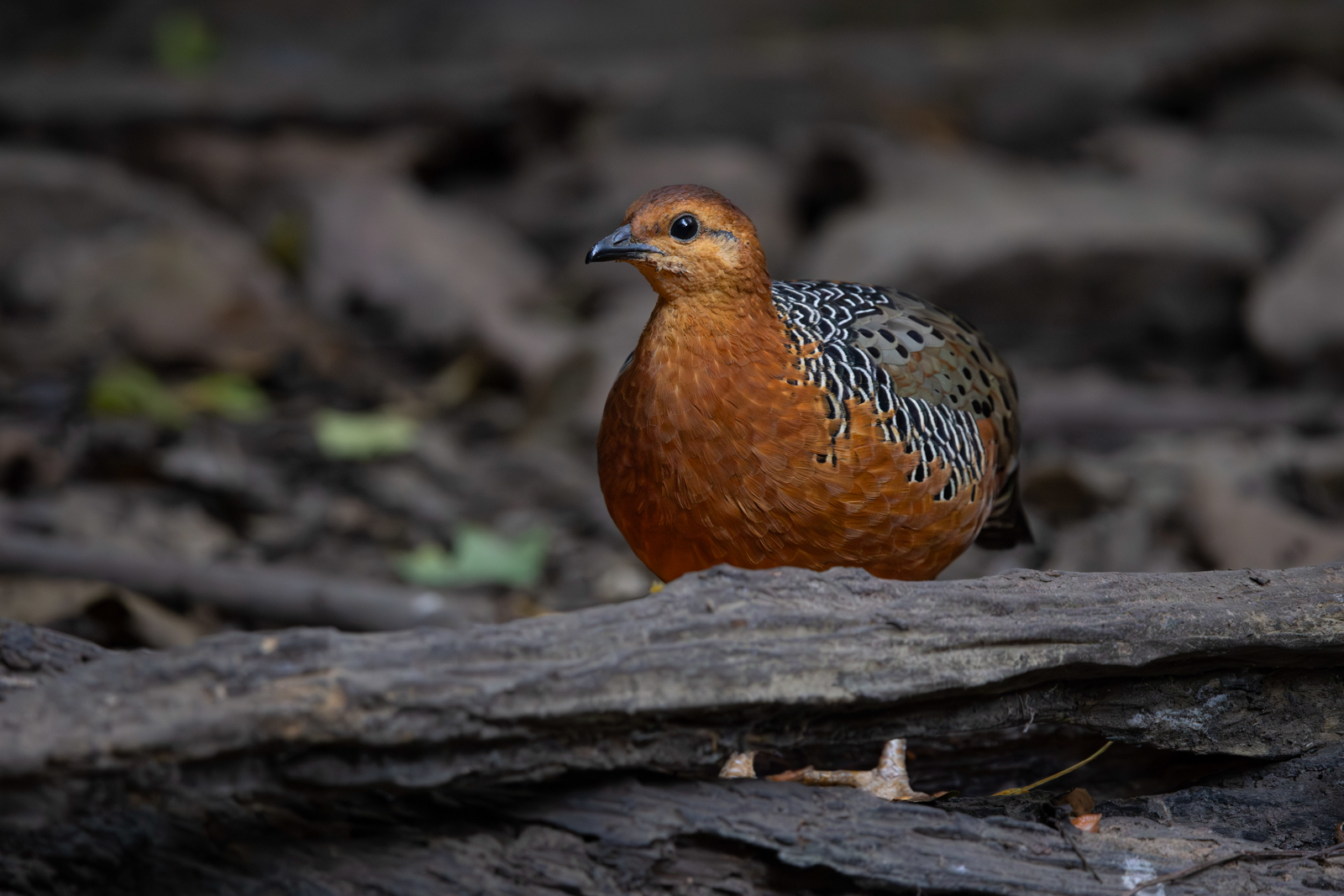
Ferruginous Partridge © Chris Burney
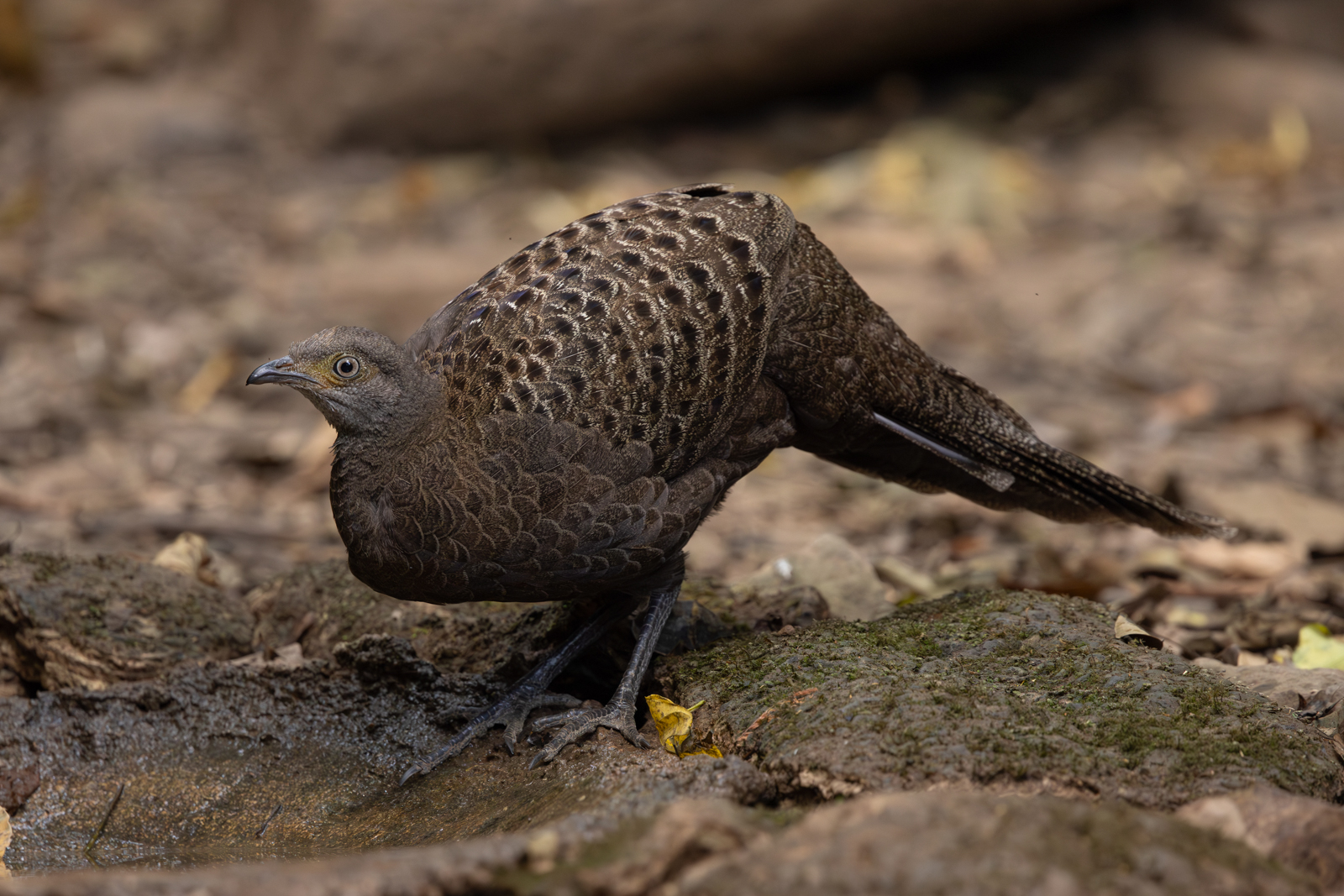
Gray Peacock-Pheasant © Chris Burney
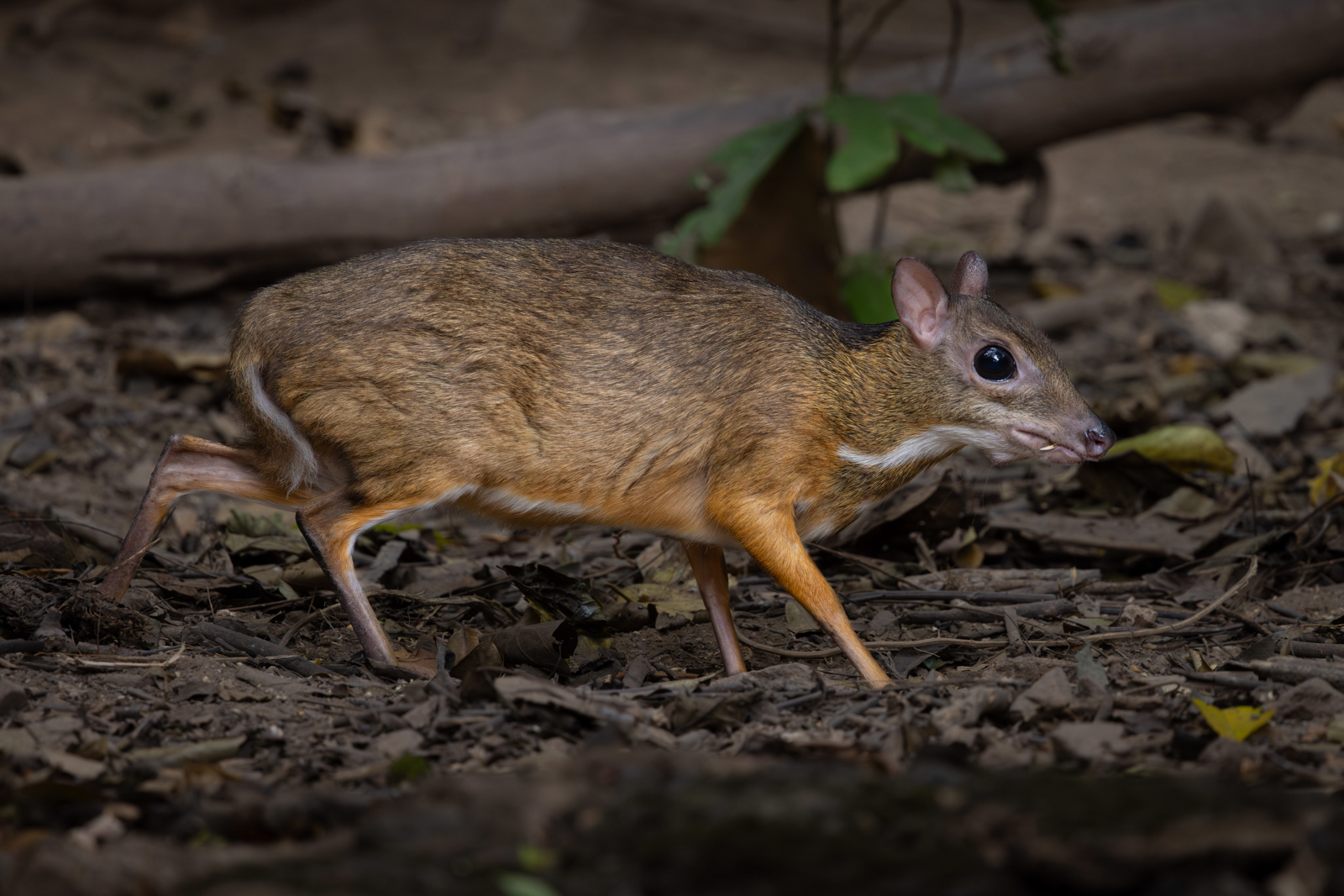
Lesser Oriental Chevrotain © Chris Burney
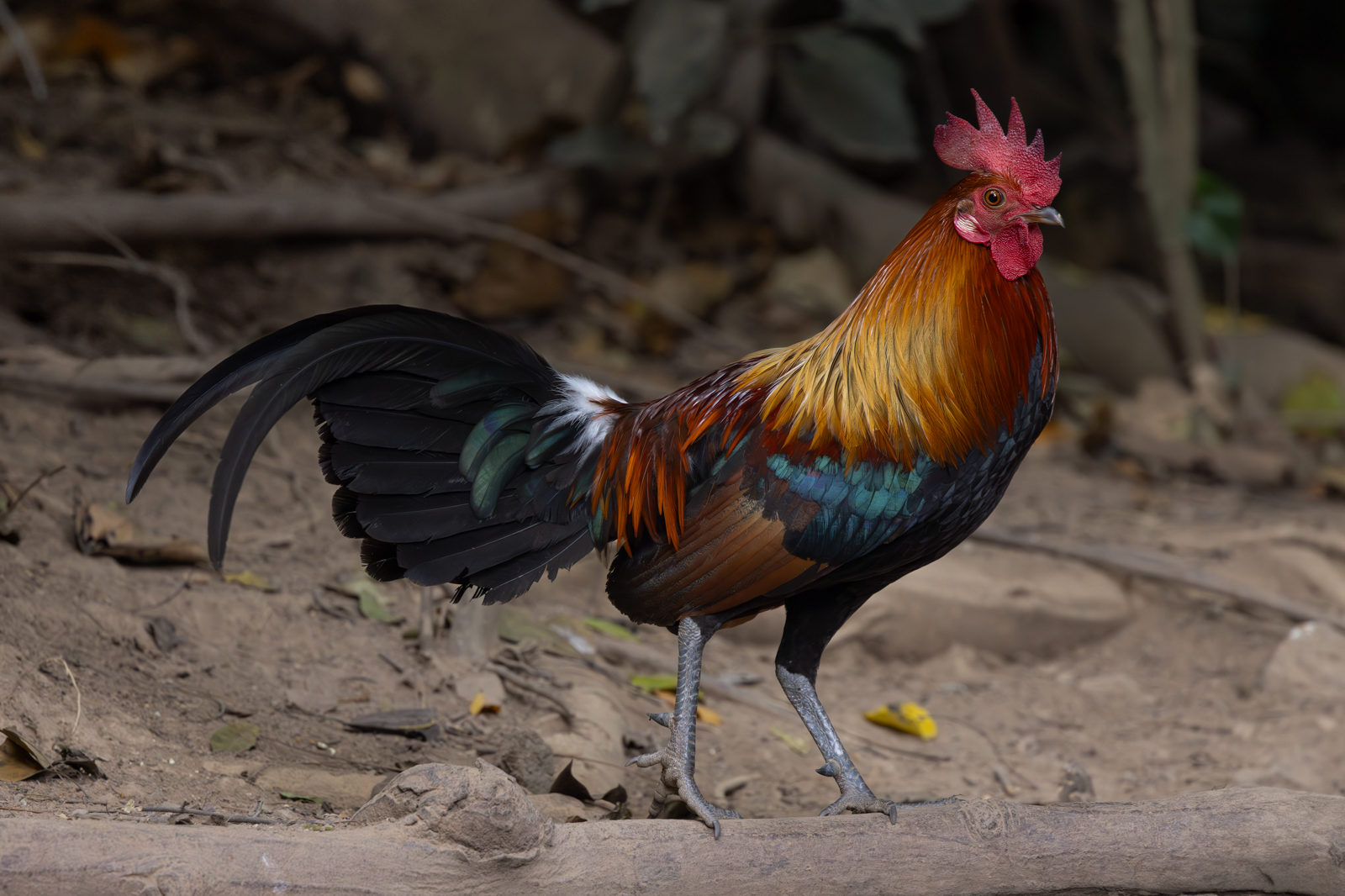
Red Junglefowl © Chris Burney
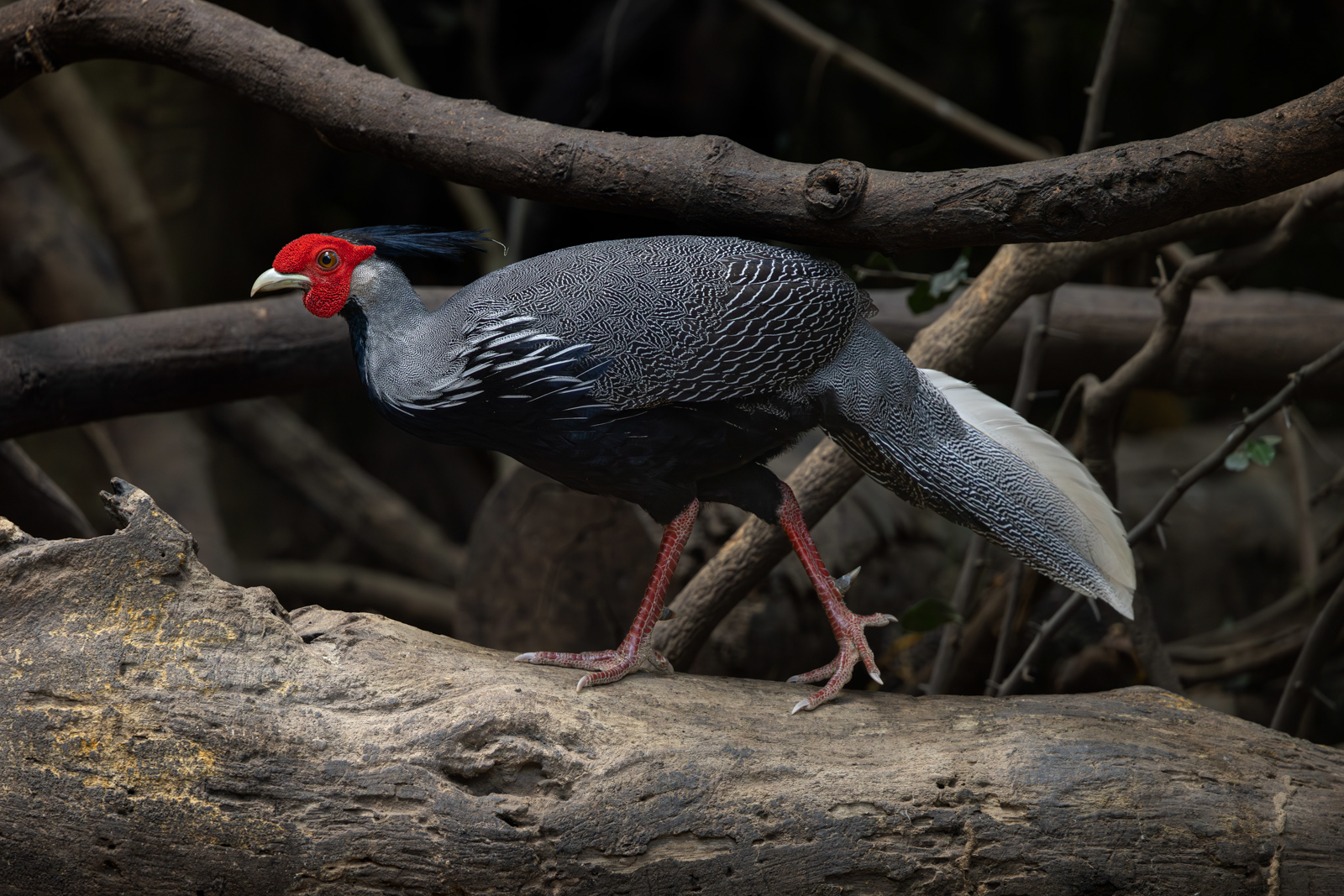
Kalij Pheasant © Chris Burney
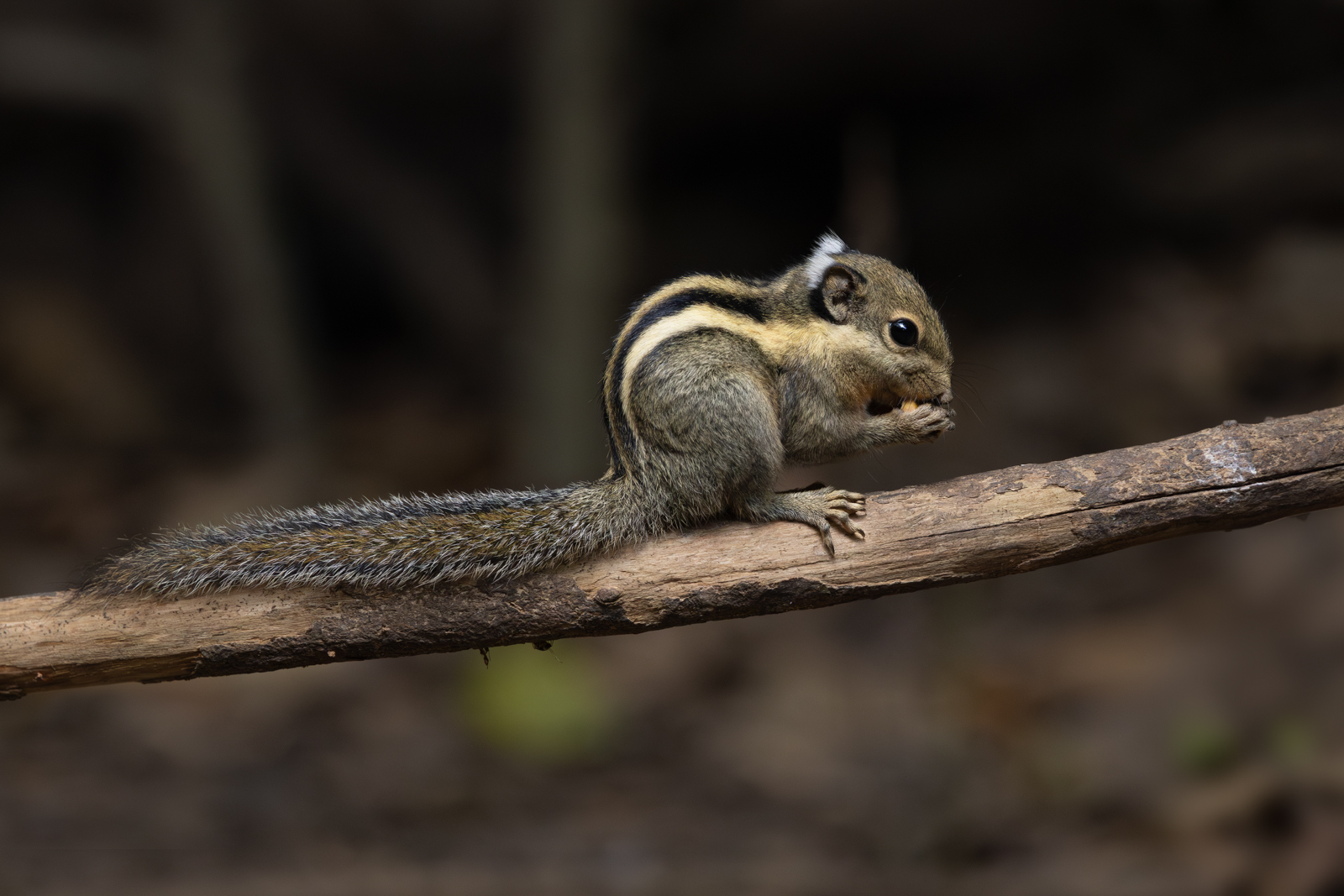
Himalayan Striped Squirrel © Chris Burney
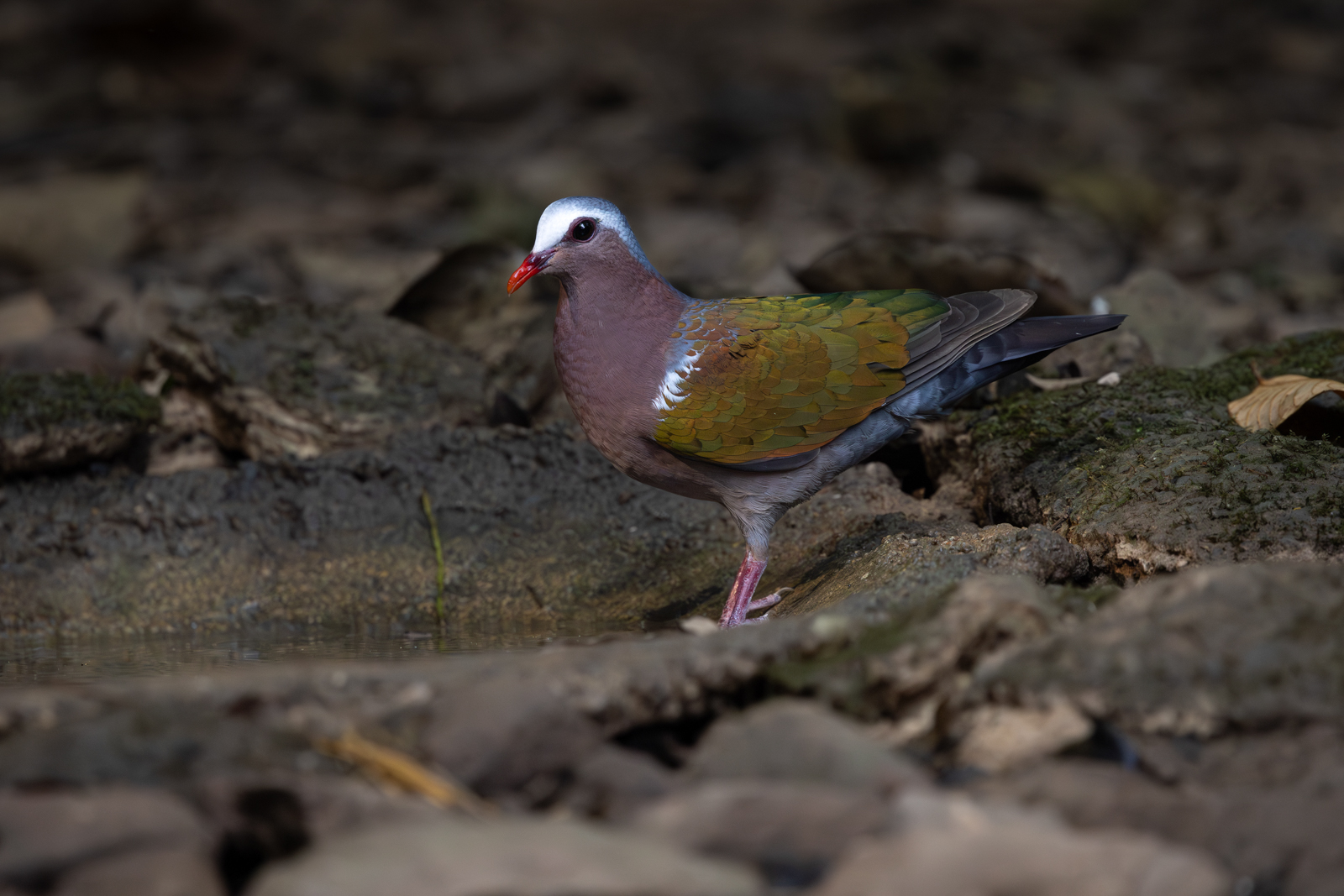
Asian Emerald Dove © Chris Burney
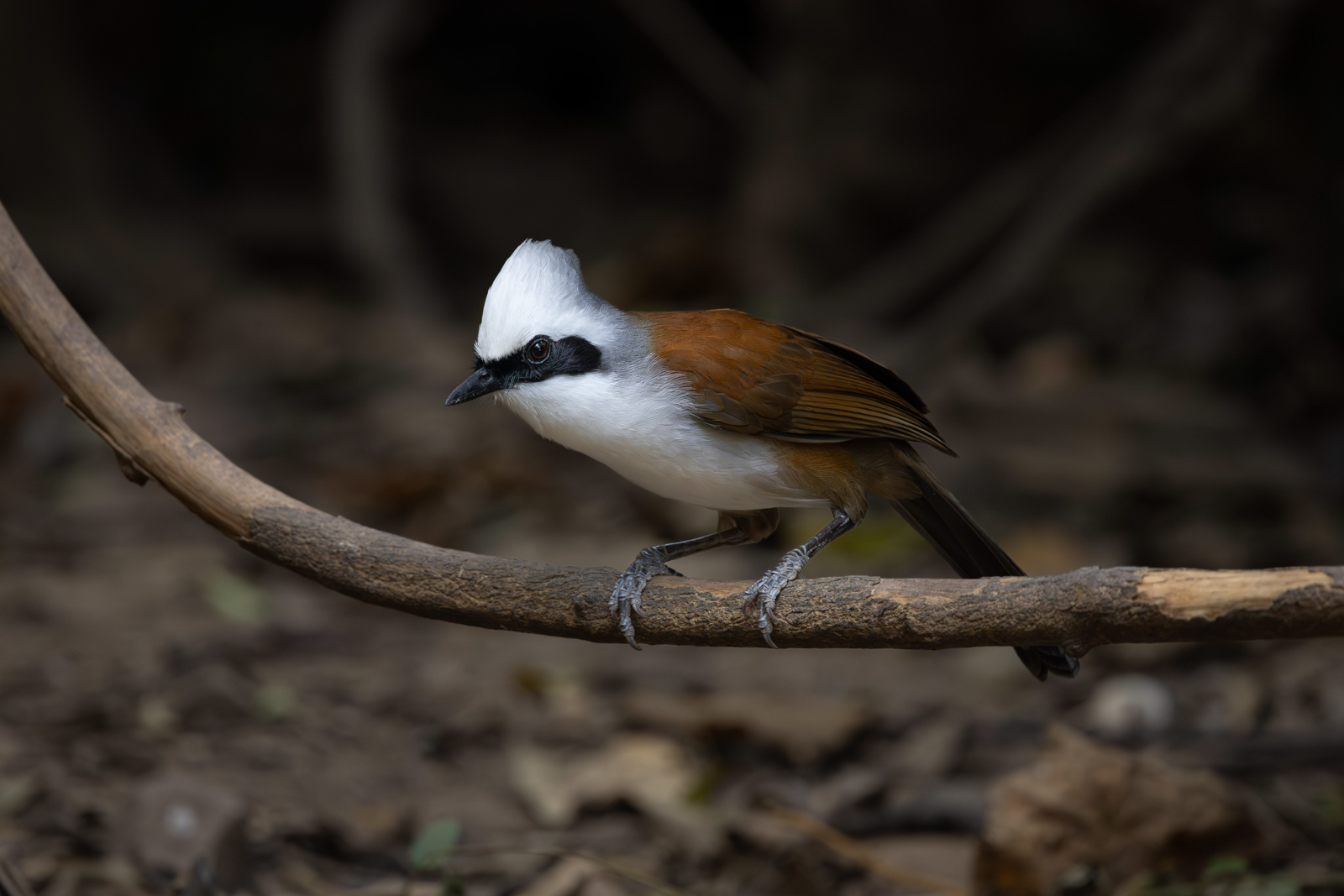
White-crested Laughingthrush © Chris Burney
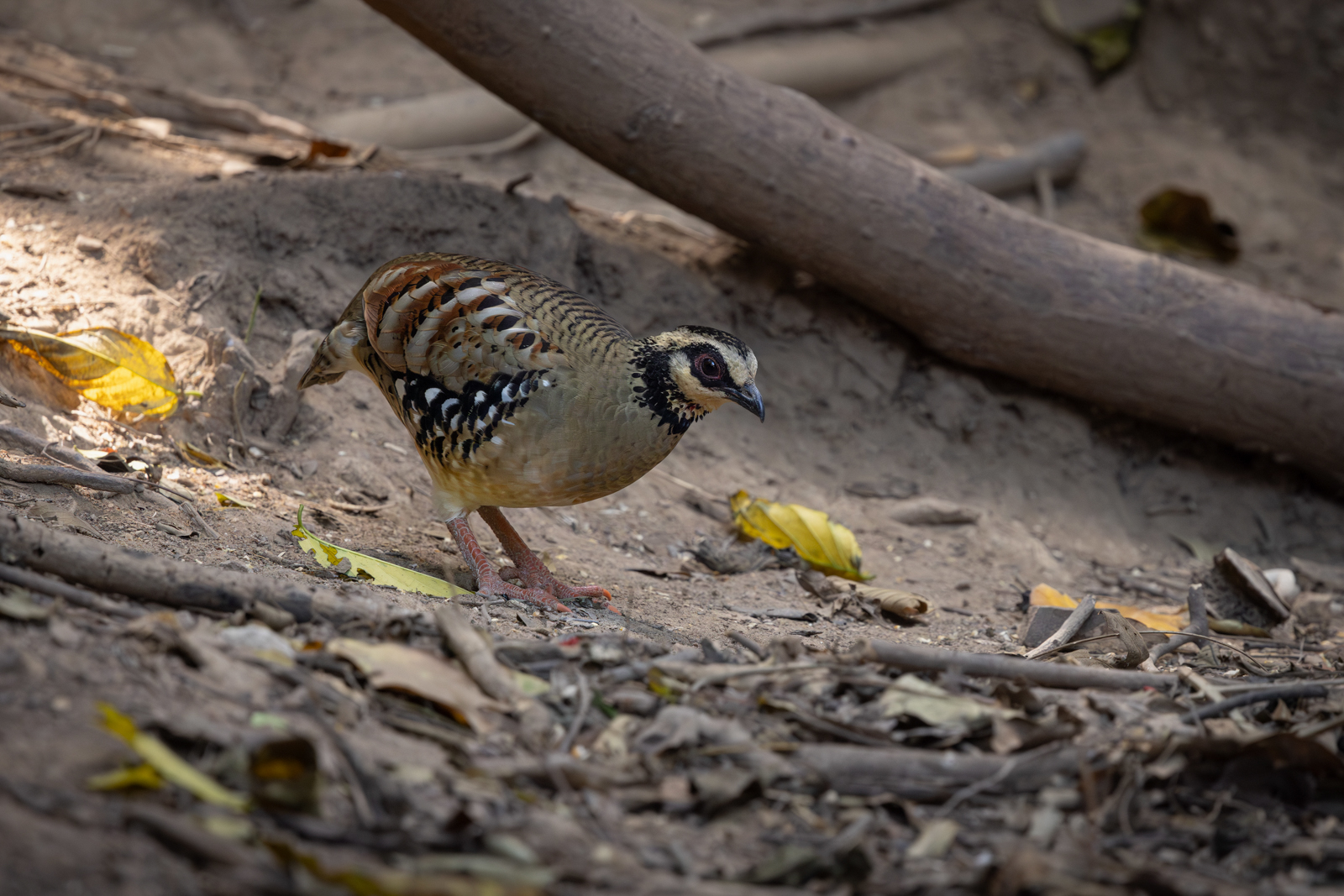
Bar-backed Partridge © Chris Burney
After dinner, we did a quick night walk around the lodge and found Indian Nightjar and Indochinese Bushlark.
Day 6
Before we departed for Khao Yai National Park, we birded the lodge grounds and neighbouring farm fields, and had some great looks at some great birds – namely, Indian Thick-knee, Brown Boobook, and Chestnut-capped Babbler. Other highlights included Banded Bay Cuckoo, Crested Goshawk, White-throated Kingfisher, Blue-bearded Bee-eater, Indochinese Roller, Lineated Barbet, Black-hooded Oriole, and Dusky Warbler.
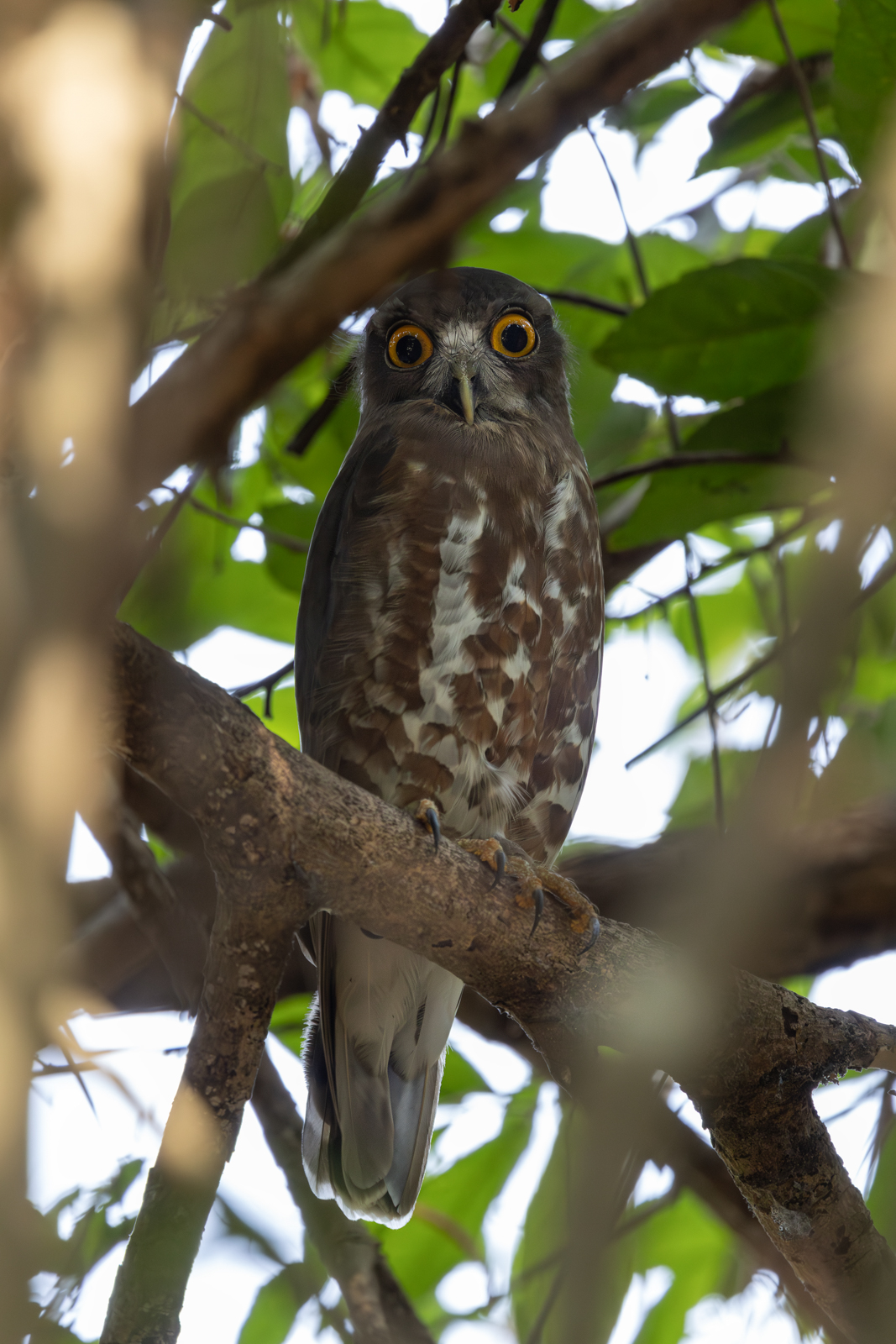
Brown Bookook © Chris Burney
Rufous Limestone Babbler is restricted to a small region of limestone outcrops in central Thailand, and we made a quick stop at Wat Phra Phuttabat Noi, a beautiful temple nestled in the karst landscape that is a well-known location for this species. Eventually after much searching, we found a pair at close range. Other highlights were Black-naped Monarch, Gray-headed Canary-Flycatcher, Pale-legged Leaf Warbler, Rufous Limestone Babbler, and Blue Rock-Thrush.
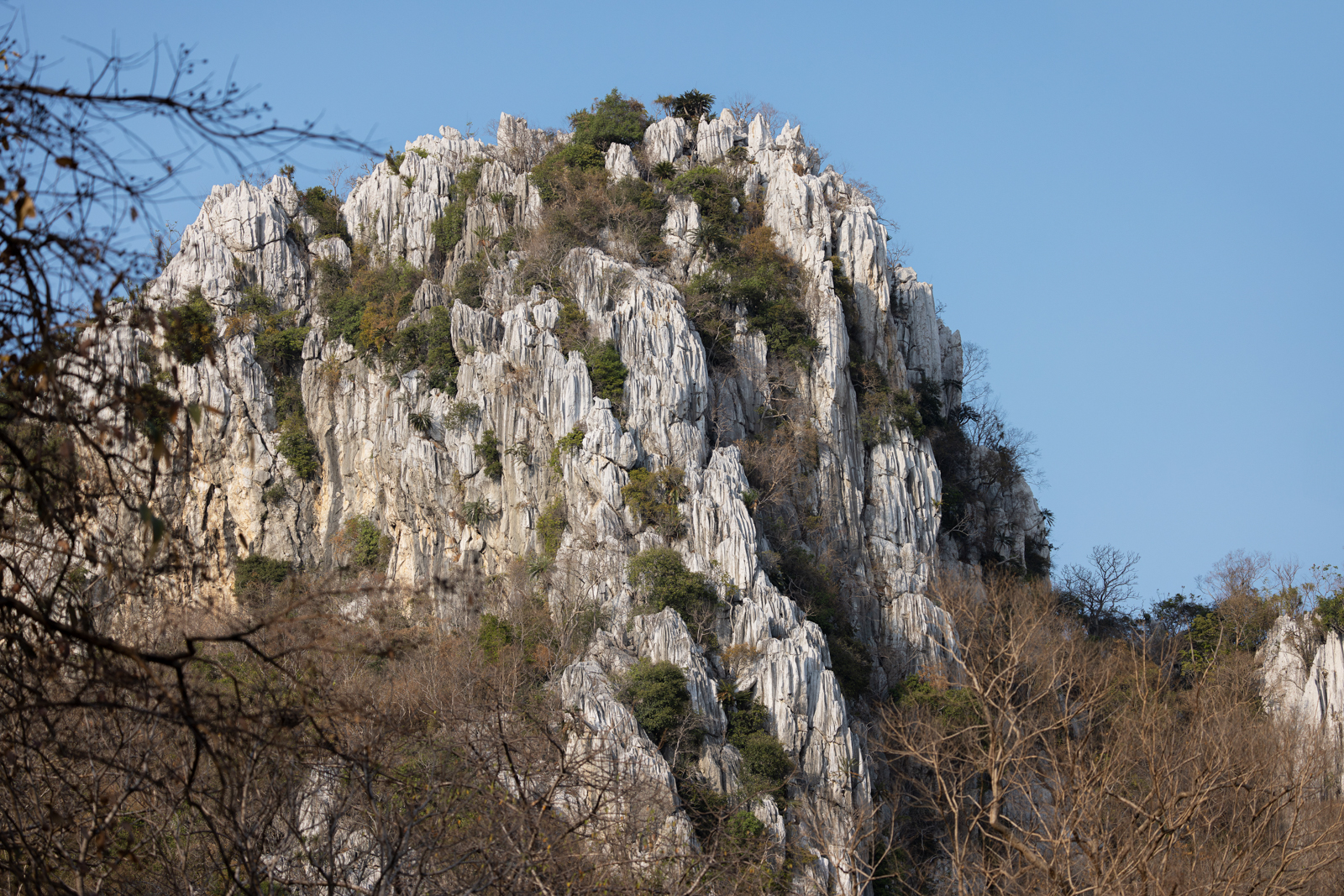
Wat Phra Phutthabat Noi Karst landscape © Chris Burney
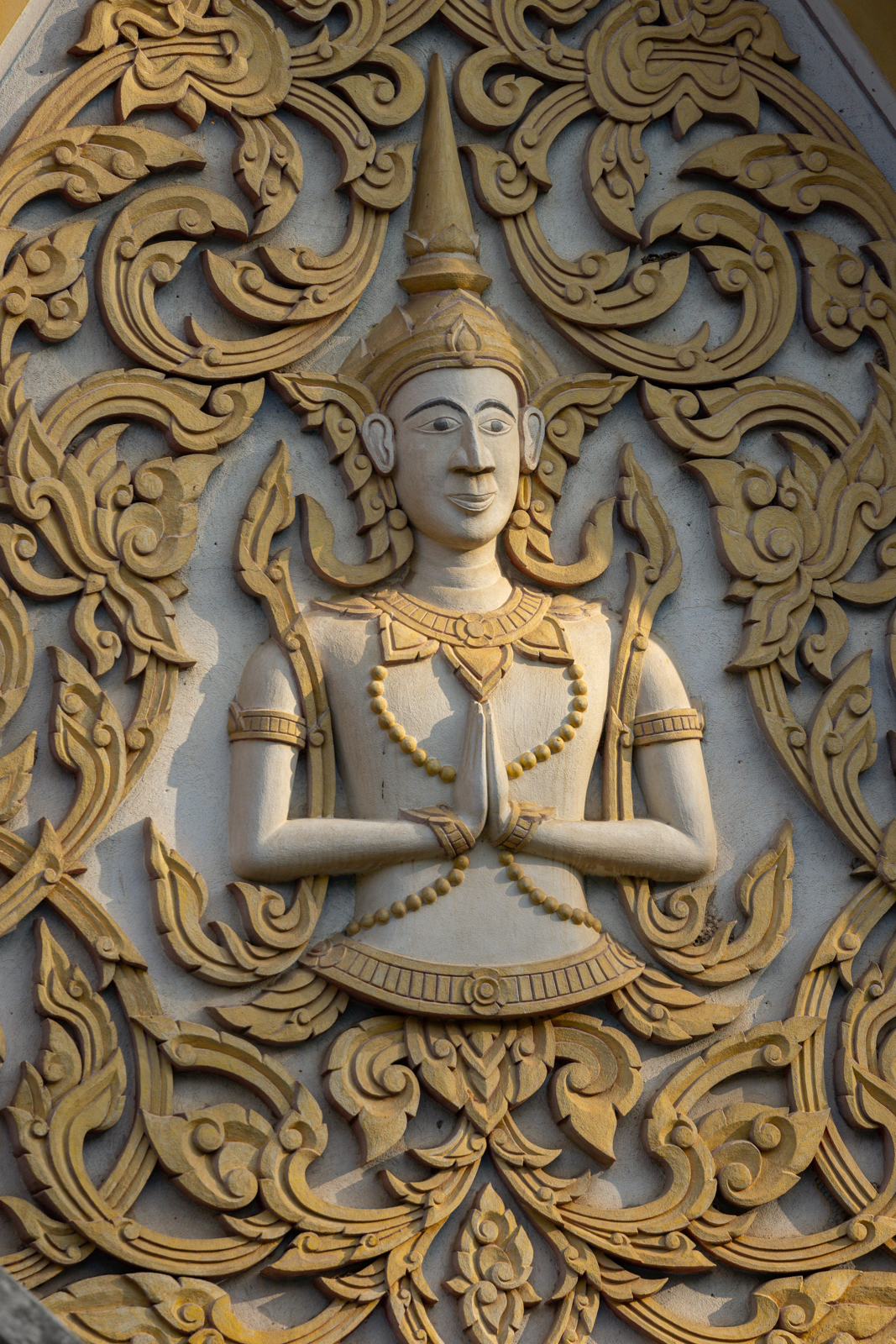
Wat Phra Phutthabat Noi © Chris Burney
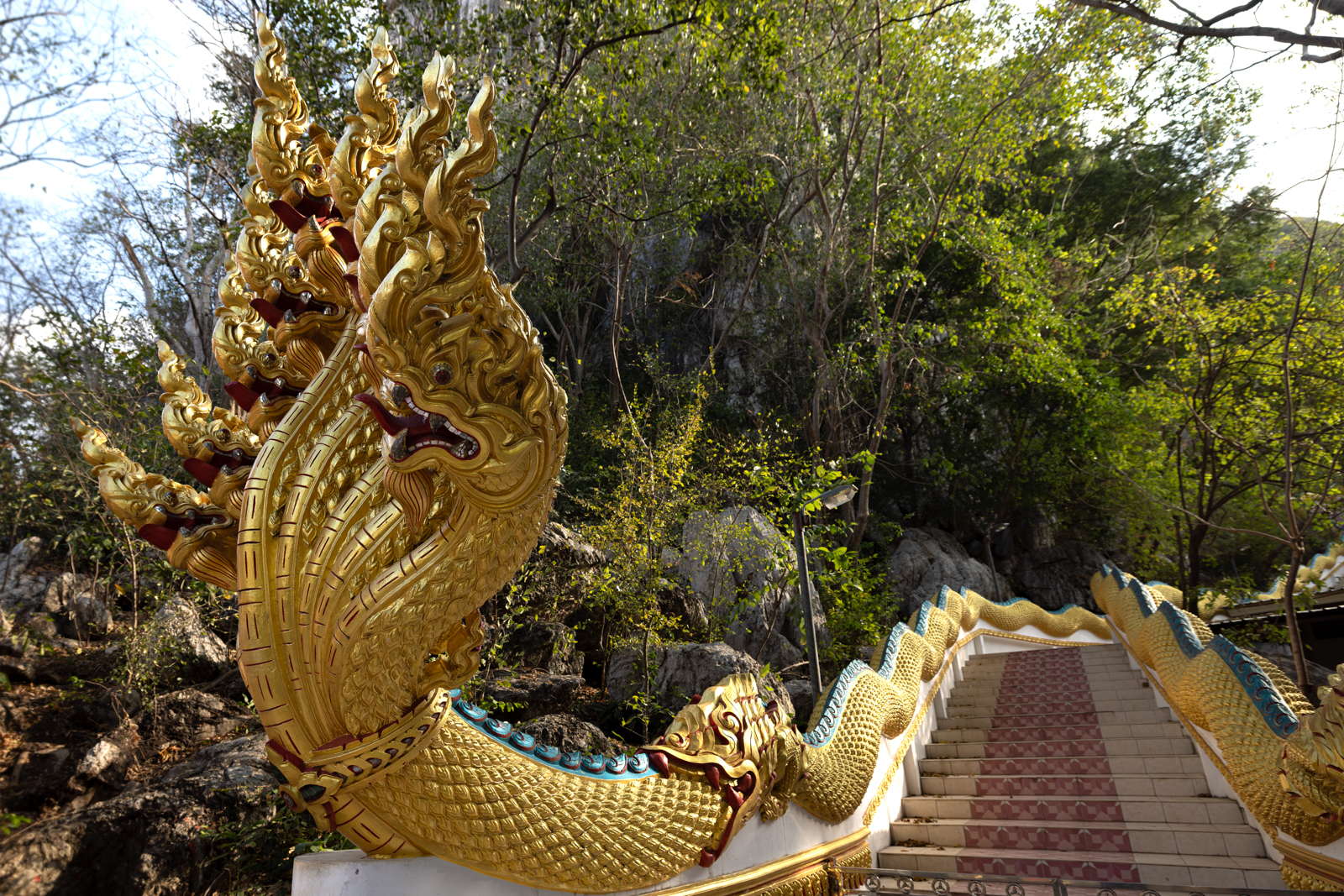
Wat Phra Phutthabat Noi © Chris Burney
At dusk, we visited the caves at Wat Tham Sila Thong to watch the exodus of thousands of White-lipped Free-tailed Bats and the raptors that feed on them. Highlights included Shikra, Gray-faced Buzzard, Pied Harrier and Pied Bushchat.
Back at the lodge, we heard and briefly observed a Great-eared Nightjar.
Day 7
We spent all day exploring Thailand’s first national park, Khao Yai which was established in 1962. This is the third largest national park covering an area of 2,168 square kilometres (837 sq. miles). It is part of a larger network of protected areas called Dong Phayayen-Khao Yai Forest Complex, a World Heritage Site declared by UNESCO that includes five other conservation areas that extend to the Cambodian border. We went up and down visiting the various hot spots along an elevational gradient to maximize our chances of seeing a large number of species. The strategy eventually paid off, we finished with some extremely hard to find species such as Spot-bellied Eagle-Owl, Silver Pheasant, Siamese Fireback, and Coral-billed Ground-Cuckoo! It didn’t end there, for mammals, we saw Pileated Gibbon and Mainland Serow! Other highlights included Asian Emerald Cuckoo, Black Eagle, Besra, Oriental Honey-buzzard, Buffy Fish-Owl, Collared Owlet, Sultan Tit, Black-throated Laughingthrush, Cambodian Flowerpecker, Orange-breasted Trogon, Wreathed Hornbill, Great Hornbill, Greater Flameback, Heart-spotted Woodpecker, Long-tailed Broadbill, White’s Thrush, Brown-backed Needletail and Great Eared-Nightjar. For mammals: Red Muntjac, Sambar, Black Giant Squirrel and Northern Pig-tailed Macaque.
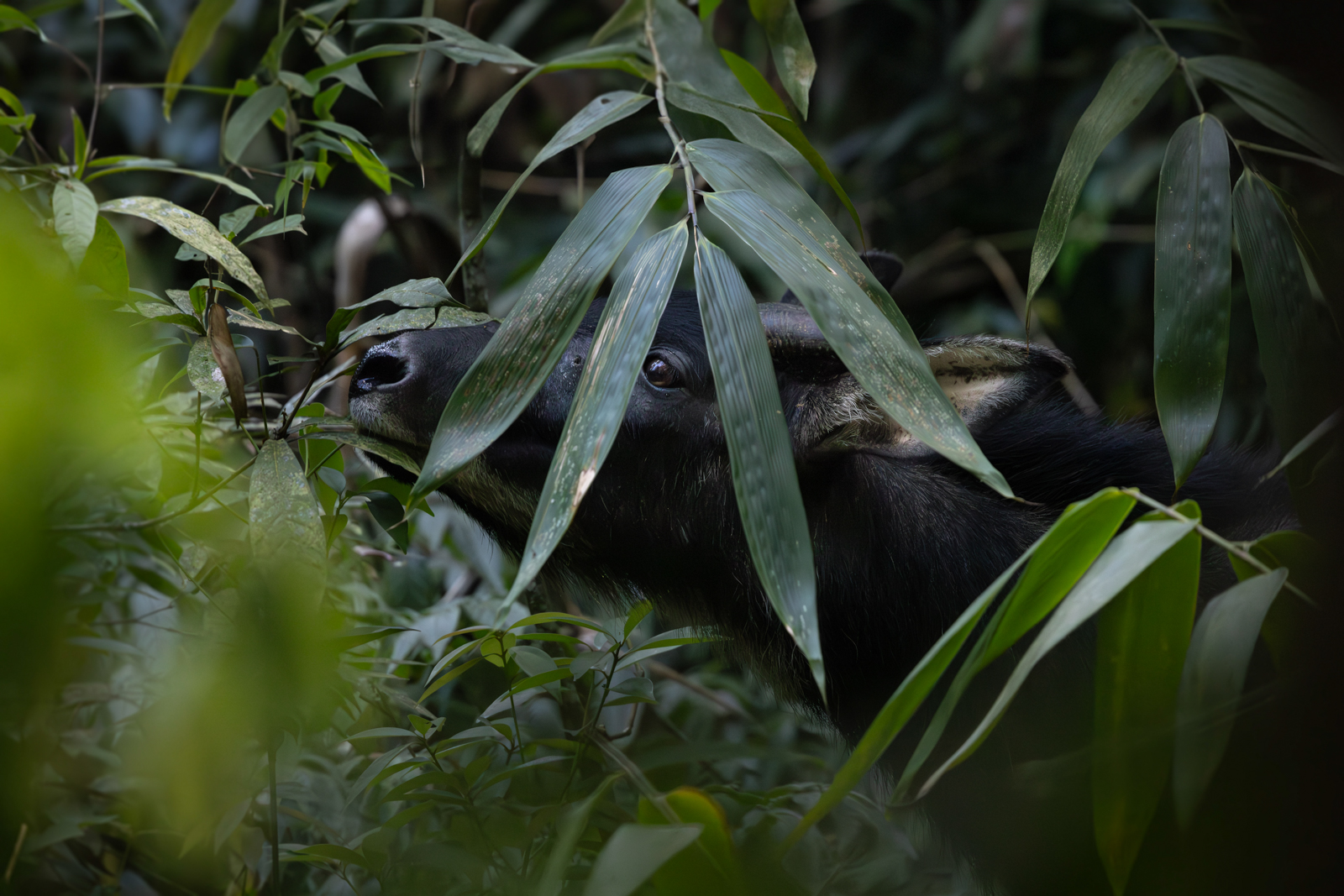
Mainland Serow © Chris Burney
Day 8
We spent the morning before our flight north in Khao Yai National Park again, retracing our path the previous day and visiting some new sections. We managed to find a few new ones for the trip such as Red-headed Trogon, Gray-headed Woodpecker, Violet Cuckoo, and Crimson Sunbird.
After landing in Chang Rai, we made our way to our hotel in Fang and made one stop at Tha Ton. These agricultural lands regularly attract wintering birds rare elsewhere in Thailand, and are a well-known roost for various buntings. Our highlights included Little Ringed Plover, Temmninck’s Stint, and Small Pratincole.
Day 9
We visited a large mixture of sites around Doi Ang Khang along the border with Myanmar. Near the military base and campground, we found one of our main targets, Giant Nuthatch. Other highlights in this area included Gray Treepie, Golden-throated Barbet, Striped-breasted Woodpecker, Clicking Shrike-Babbler, Yellow-cheeked Tit, Yunnan Fulvetta, Blue-winged Minla, Spectacled Barwing, Rufous-backed Sibia, Black-backed Sibia, Chestnut-vented Nuthatch, and Fire-breasted Flowerpecker, Streaked Spiderhunter and Yellow-streaked Warbler.
Further up the road, we found another nice mix of species such as White-browed Shrike-Babbler, Silver-eared Mesia and Orange-bellied Leafbird. We then visited a temple, Wat Phra That Doi Ang Khang, to look for thrushes, finding Black-breasted Thrush and not much else. After lunch, we visited the beautiful grounds of the Royal Agricultural Station and scored Black Bulbul, Red-whiskered Bulbul, Blue Whistling-Thrush and White-tailed Robin. Our last planned stop was a border checkpoint where we found a very cooperative Burmese Shrike and many Cook’s Swifts flying overhead. On the way back down the hill, we got lucky and found another Giant Nuthatch and an unexpected Peregrine Falcon.
Day 10
We started early today in Doi Pha Hom Pok National Park (Doi San Ju) to get our blinds in position for a stakeout for Hume’s Pheasant, and we eventually had great views of a male and several females. Other birds that visited the blind include Oriental Turtle-Dove, Black-throated Tit, Red-eyed Scimitar-Babbler, Giant Nuthatch and various Flycatchers: Slaty-backed, Rufous-gorgeted, Sapphire, and Ultramarine.
After the show, we spent the remainder of the day travelling along the border with Myanmar looking for mixed flocks–highlights included Mountain Bamboo-Partridge, Maroon Oriole, Crested Finchbill, Brown-breasted Bulbul, Spot-breasted Parrotbill, Golden Babbler, Himalayan Cutia, Scarlet-faced Liocichla, Spot-breasted Laughingthrush, Hume’s Treecreeper, Large Niltava, Rufous-bellied Niltava, Slaty-blue Flycatcher, Chestnut-bellied Rock-thrush and Spot-winged Grosbeak.
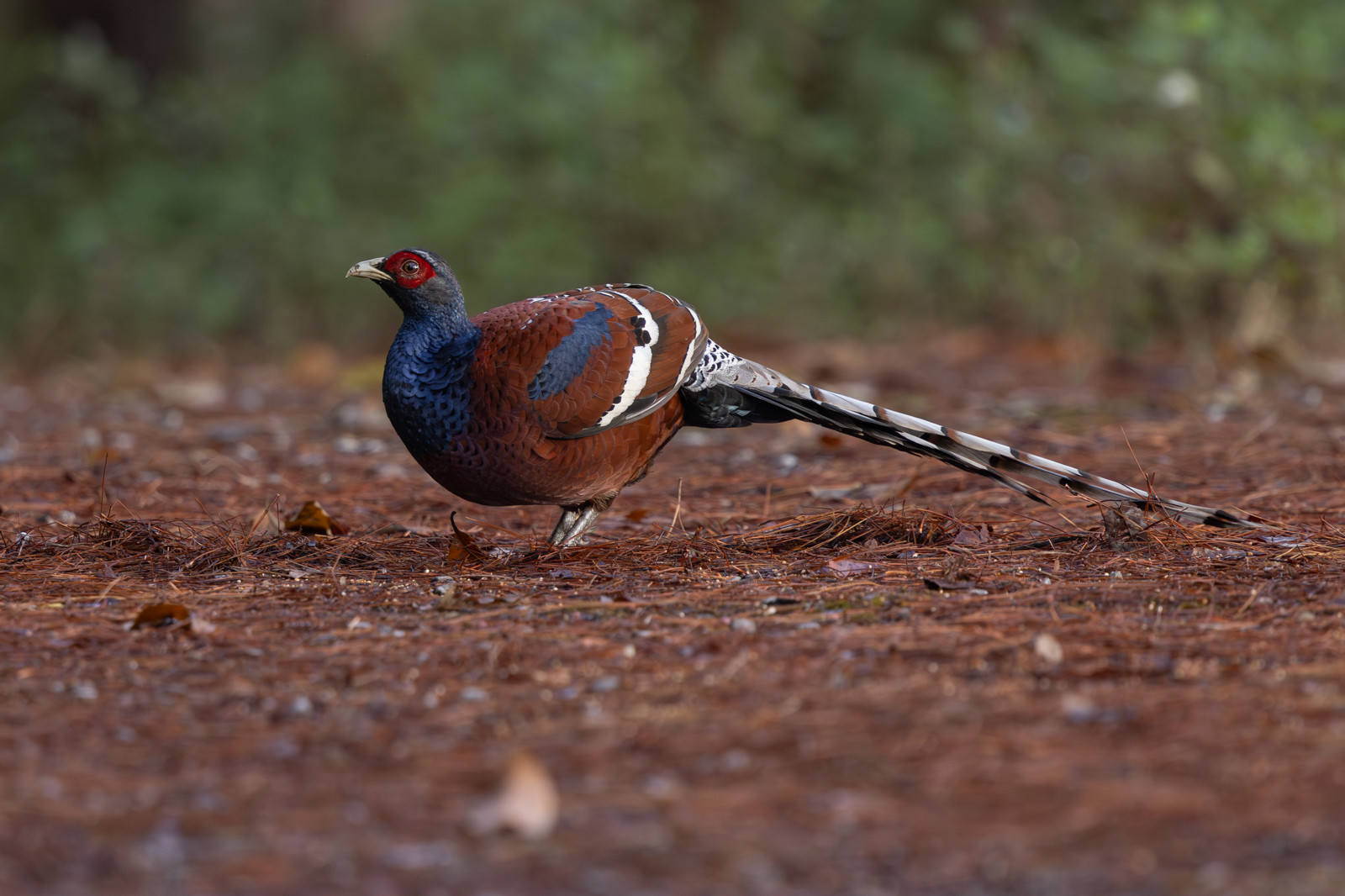
Mrs. Hume’s Pheasant (male) © Chris Burney
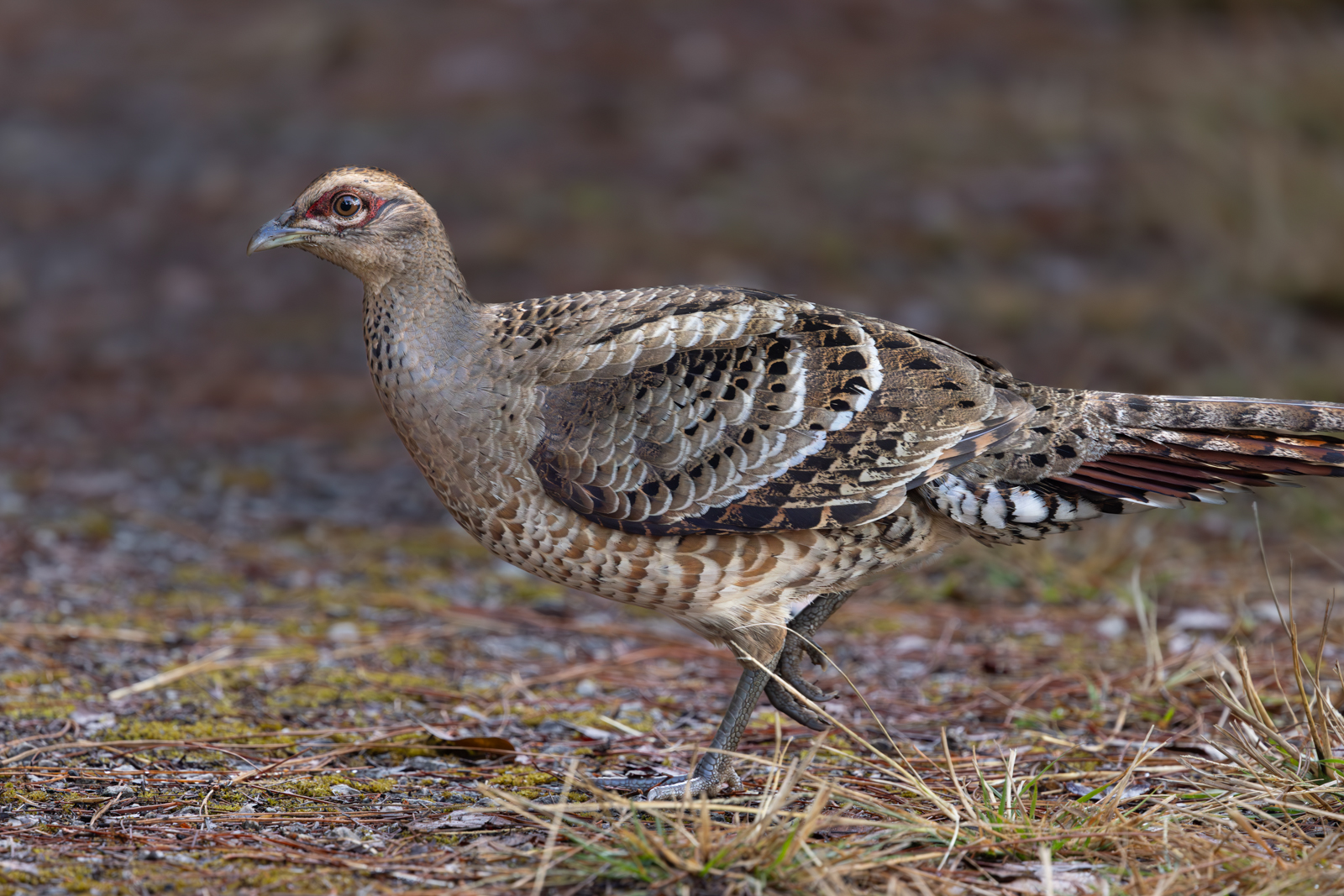
Mrs. Hume’s Pheasant (female) © Chris Burney
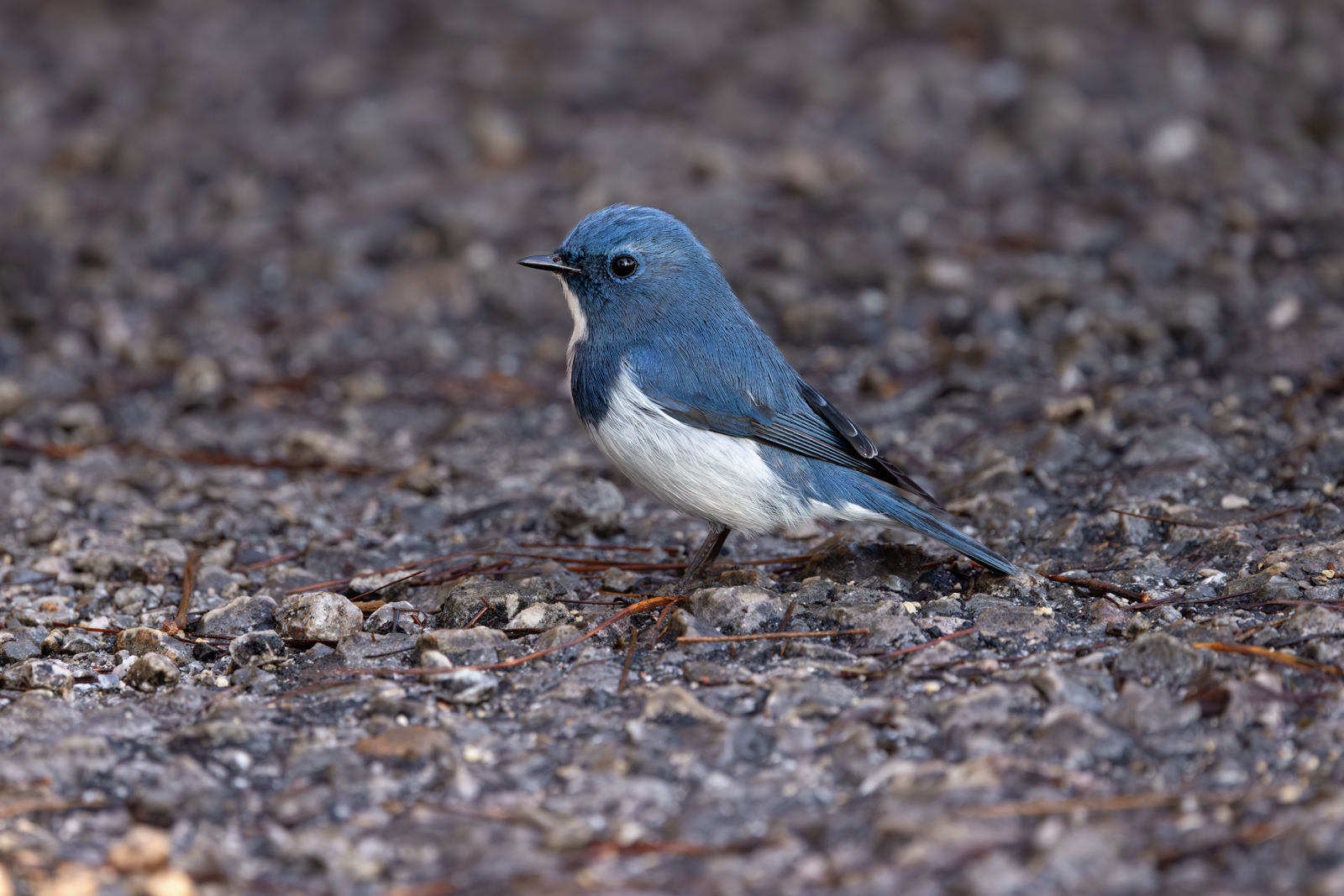
Ultramarine Flycatcher © Chris Burney
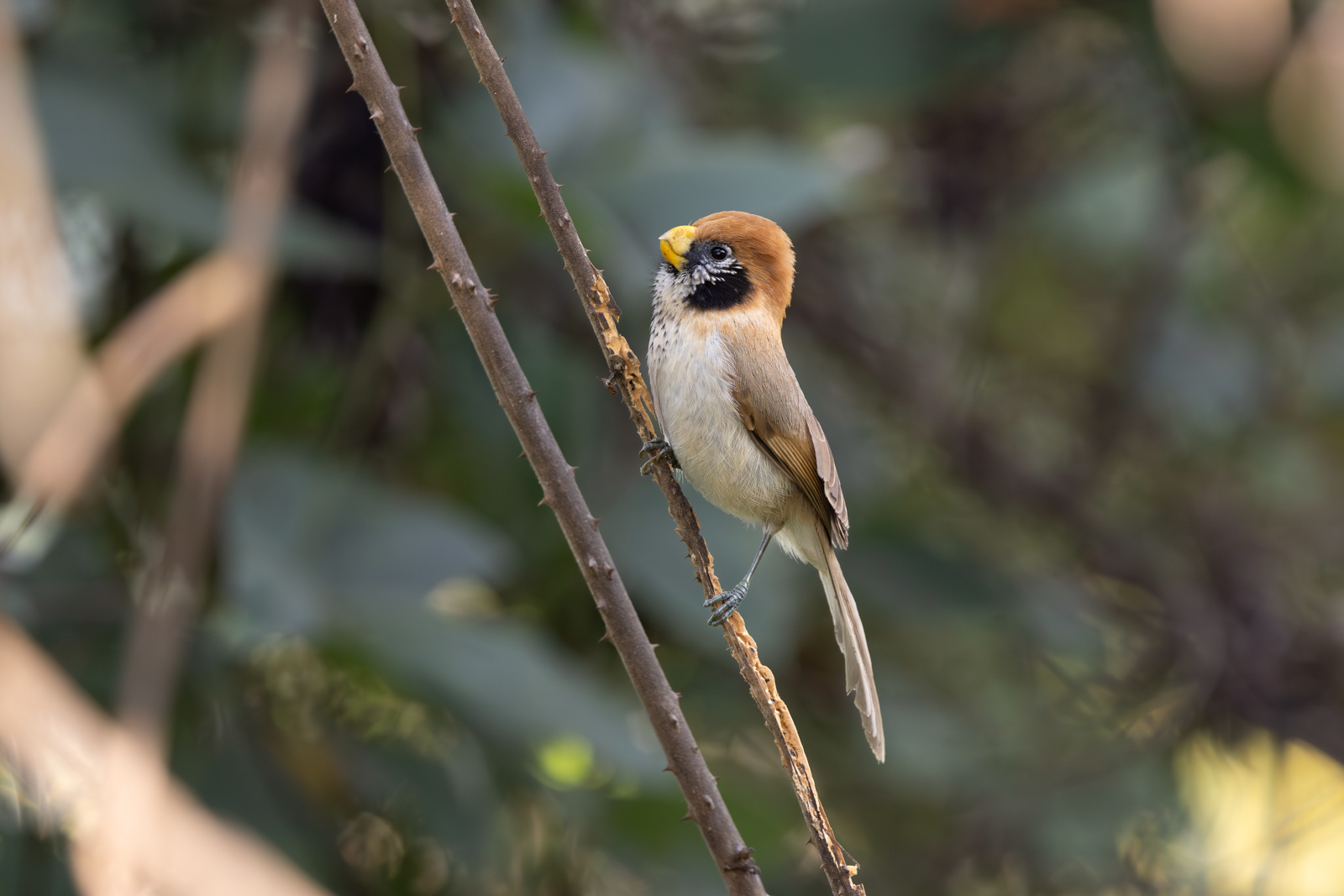
Spot-breasted Parrotbill © Chris Burney
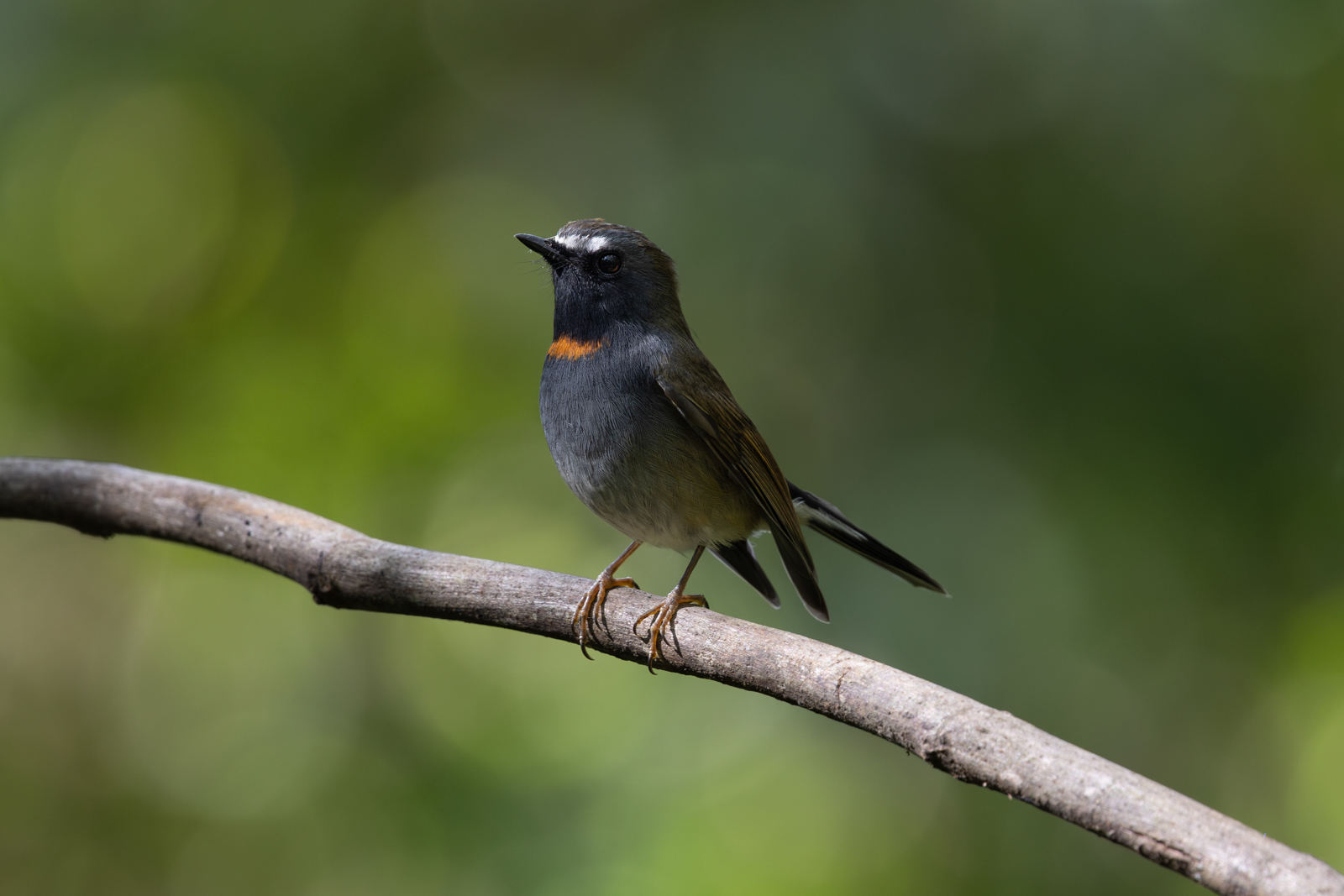
Rufous-gorgeted Flycatcher © Chris Burney
Day 11
On our drive towards Chiang Mai, we made a number of stops at a mixture of habitats. We started at Chiang Dao Wildlife Sanctuary finding a few new species for the trip including Asian Emerald Cuckoo, Bay Woodpecker, Bar-winged Flycatcher-shrike, Velvet-fronted Nuthatch and Asian Fairy-bluebird.
Next, we stopped at Mae Taeng Irrigation Project and picked up the very rare and continuing Long-billed Plover. Other birds included Crested Treeswift, Green Sandpiper, more Small Pratincoles and Wire-tailed Swallow.
At lunch in Chiang Mai, we found a Common Kingfisher. We then headed outside of Chiang Mai into a vast region of rice paddies which is a well-known location for unusual raptors – we found Booted Eagle, Steppe Eagle, Shikra, Pied Harrier, Black Kite, Eurasian Kestrel and Peregrine Falcon.
Towards the end of the day, we made our last stop at Ban Hong Wildlife Reserve to look for Green Peafowl. We soon saw many at close range with a few males displaying spectacularly for the females.
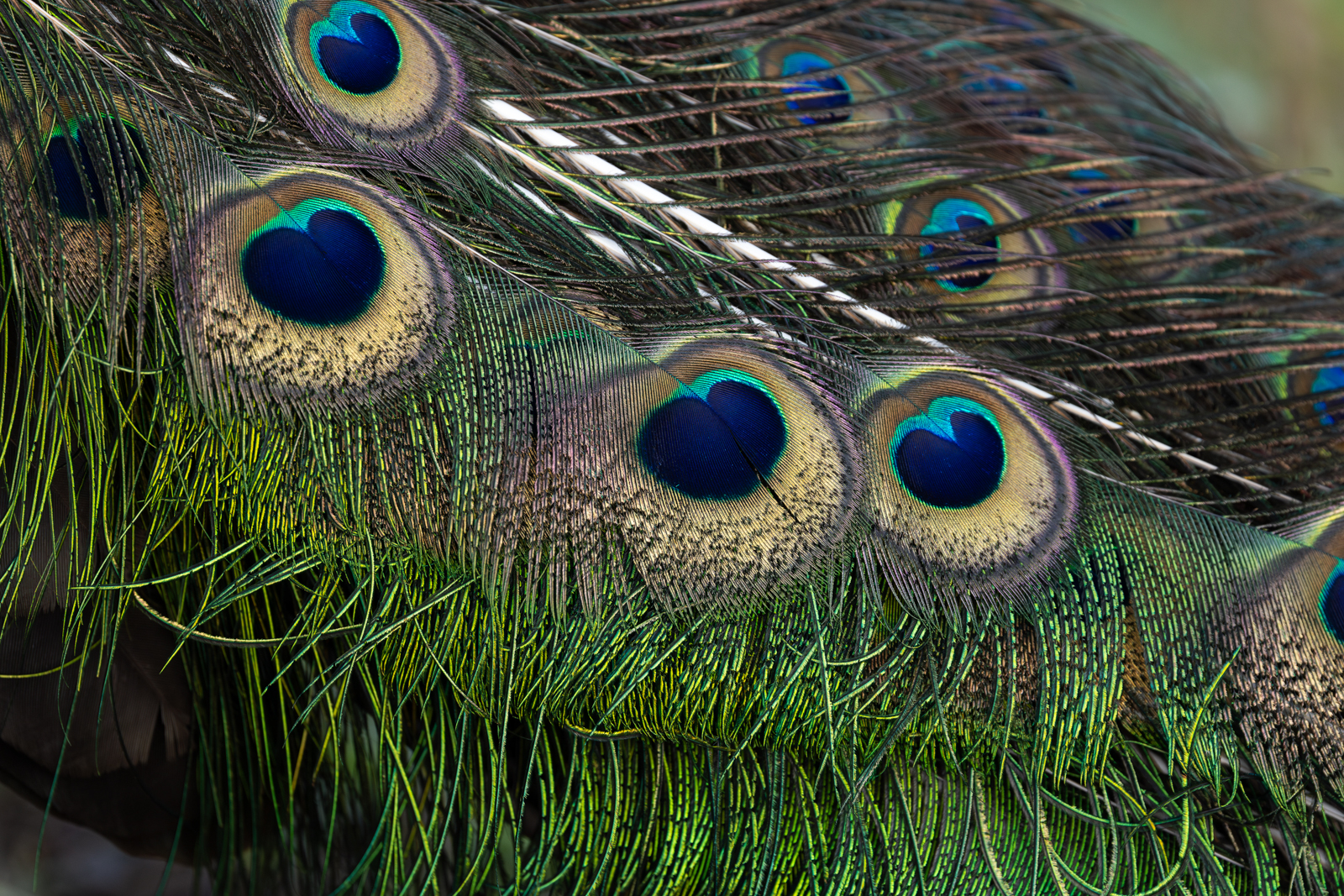
Green Peafowl feathers close-up © Chris Burney
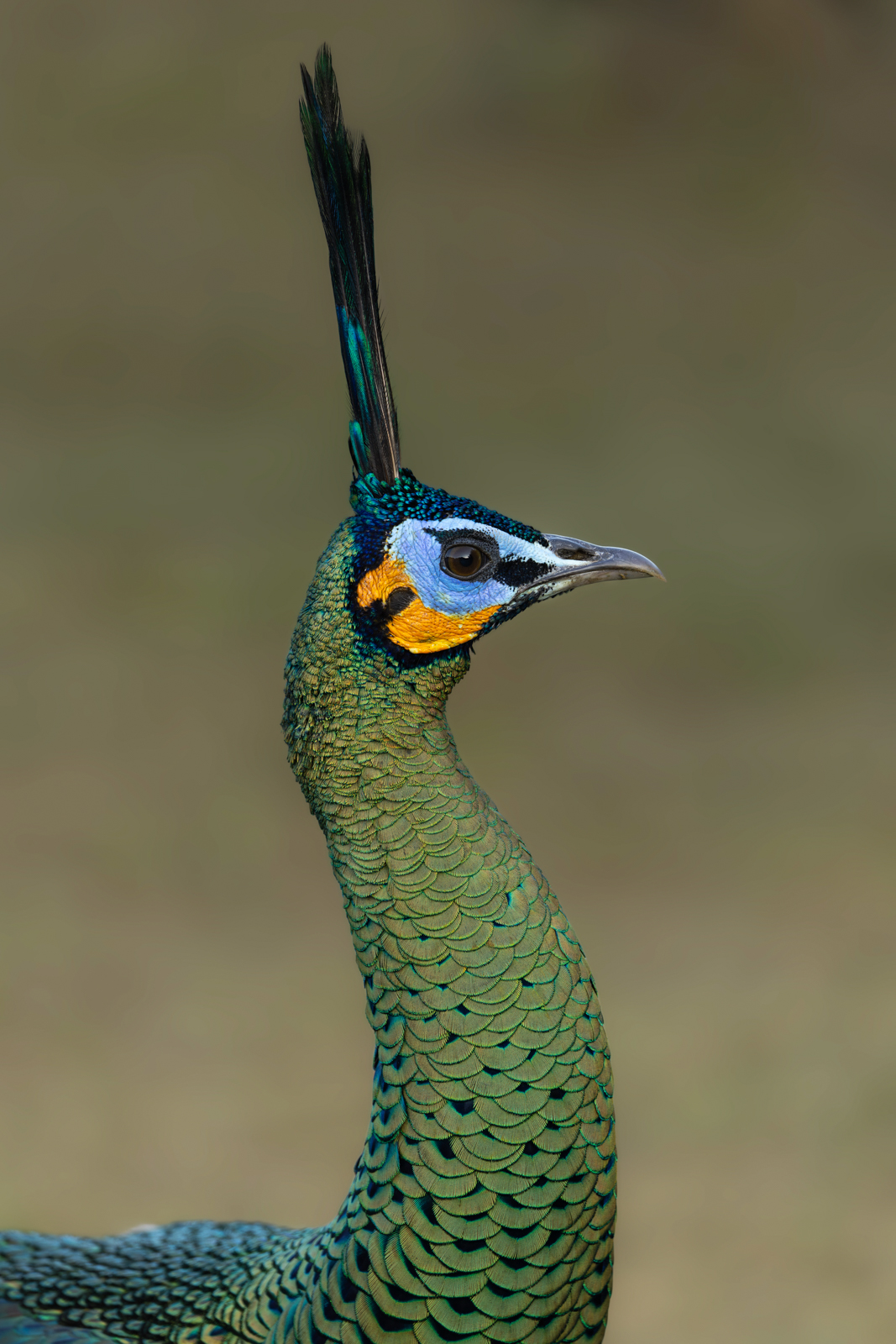
Green Peafowl © Chris Burney
Day 12
We started the day at the summit of Doi Inthanon National Park, an area of upper montane forest found nowhere else in Thailand with plant and animal species more commonly associated with the Himalayas. Amongst the evergreen cloud forest, sphagnum bog and relict pines we found Rufous-throated Partridge, Ashy-throated Warbler, Rufous-winged Fulvetta, Silver-eared Laughingthrush, Chestnut-tailed Minla, Eyebrowed Thrush, Himalayan Shortwing, and Green-tailed Sunbird (Doi Inthanon). Further down hill, we explored a lower patch of dense forest and picked up several new birds including Large Hawk-Cuckoo, Great Barbet, Yellow-bellied Fairy-Fantail, Pygmy Cupwing, Marten’s Warbler, Slaty-bellied Tesia, Chestnut-crowned Warbler, White-gorgeted Flycatcher, Lesser Shortwing, Snowy-browed Flycatcher and Little Pied Flycatcher.
We had lunch further down the mountain along a small stream – a well-known spot for White-capped Redstart, Plumbeous Redstart and Slaty-backed Forktail. Asian House-Martins above us were another new tick for the list. We then checked out some hides nearby picking up White-crowned Forktail and Daurian Redstart.
Making our way back down the hill, we stopped near the dry Dipterocarp forest along Mae Lan Stream Trail and had splendid luck finding a Collared Falconet.
Almost back at the hotel, we stopped at the Blossom-headed Parakeet Conservation Area to look for more dry-forest species, highlights included Barred Buttonquail, Blossom-headed Parakeet and Rufous Treepie.
Day 13
For our last morning, we returned to the Blossom-headed Parakeet Conservation Area, and from the tower, we got much better views of the parakeets. Other highlights included more Green Peafowl and Purple Sunbirds at close range.
Before our flight back to Bangkok, we made our very last stops at a few agricultural areas hoping to pick up a few more open country/wetland species. Highlights included Yellow Bittern, Eurasian Hoopoe, Thick-billed Warbler, Oriental Reed Warbler, and Eurasian Sparrowhawk.



